
- Living In Croatia
- Croatian Recipes
- Balkan Recipes

Home > Croatian Recipes In English

Croatian Recipes In English
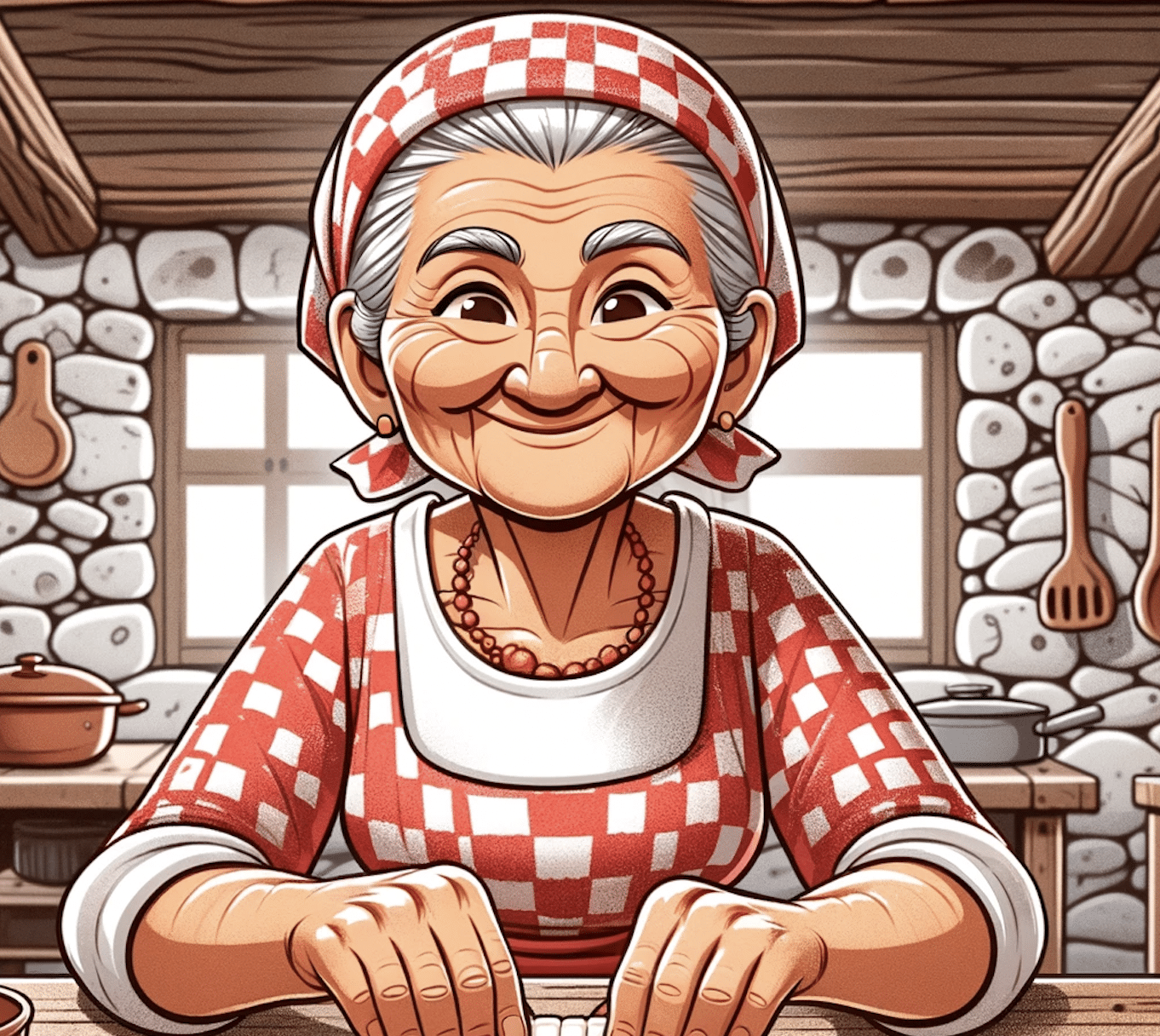
9 Weird Croatian Food To Try In Croatia (In My Opinion Anyway)
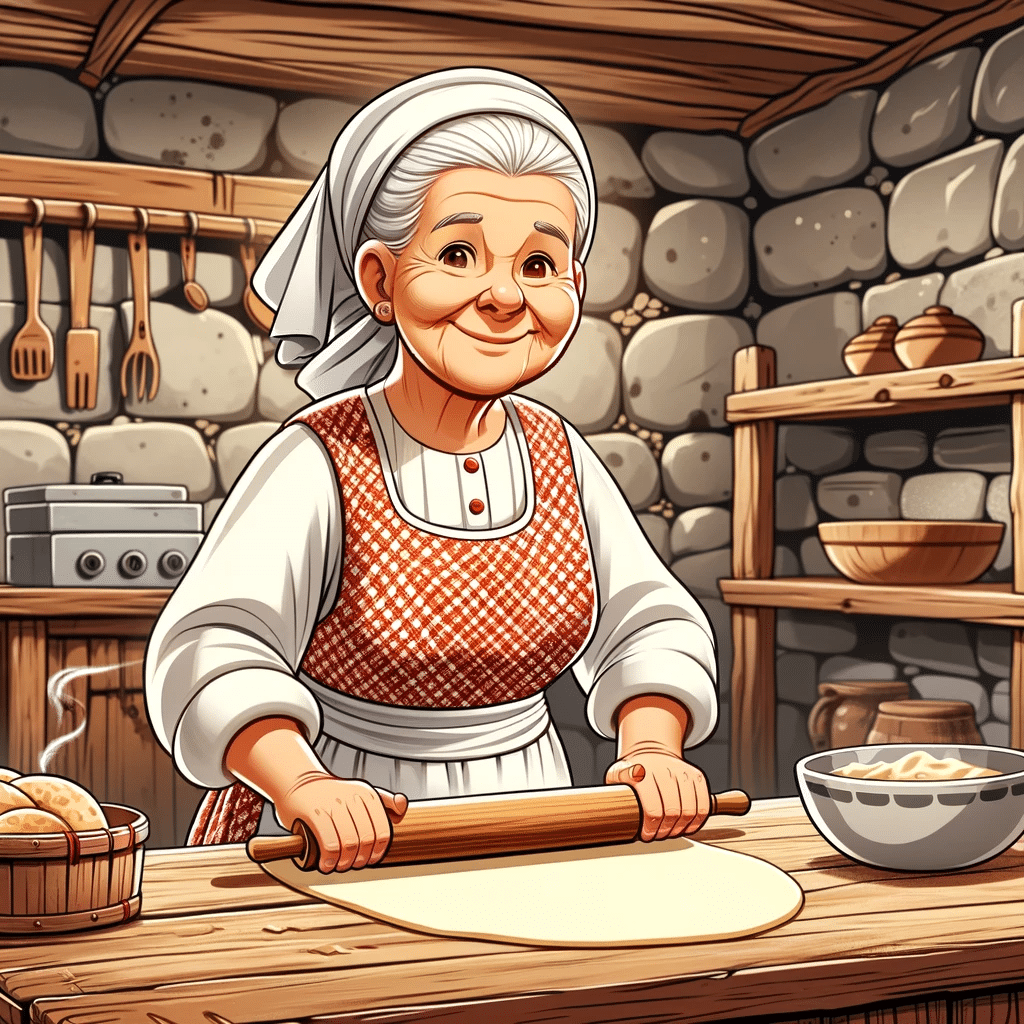
31 Delicious Croatian Desserts, Cakes & Sweets

Ispod Čripnje Or Ispod Peke Recipe – Croatian Cooking

Croatian Vanilla Crescent Cookies Recipe (Vanilin Kiflice)
Our Croatian Recipes are in English (of course!) and as with all traditional Croatian food these recipes vary slightly from the ones you may know. Each recipe is shared by either family or friends here in Croatia .
Here are our favorite recipes in English.
Ispod Čripnje Or Ispod Peke Recipe – Croatian Cooking Croatian Vanilla Crescent Cookies Recipe (Vanilin Kiflice) How To Make Croatian Šnenokle (Also Known As Paradižot) Croatian Cooking: Zagorski Štrukli (Zagorje Cheese Strukli) Čupavci Recept – Kind Of Like Australian Lamingtons How To Make Croatian Ajvar: This Is An Easy To Make Ajvar Recipe My Croatian Stuffed Peppers Recipe (Punjene Paprike) Croatian Sarma Recipe (Stuffed Cabbage Rolls) How To Make Almond Kiflice (Almond Crescent Cookie Recipe) Croatian Kremšnite Recipe (Croatian Custard Slice) Croatian Kuglof With Apples Recipe (Apple Bundt Cake) Easy Croatian Burek Recipe Croatian Kroštule (Sweet Pastry Knots) Croatian Lazy Apple Pie (Lijena Pita s Jabukama) Croatian Recipe: Rudarska Greblica Croatian Cooking: Orahnjača Recept – Walnut Roll Recipe Croatian Fritule Recipe Croatian Cooking: Carnival Krofne Recipe How To Make Croatian Pašta Fažol (Pasta and Bean Soup) Croatian Plum Dumplings Recipe (Knedle sa Šljivama) Sinjski Arambaši Recipe Croatian Jam Filled Crescents (Kiflice) Croatian Tomato Soup With Grated Dough (Juha Od Rajčice s Taranom) Croatian Brodet Recipe (Croatian Fish Stew) How To Make Croatian Christmas Cookies – Two Ways Soparnik Recipe: Here Is How To Make Poljički Soparnik Croatian Easter Bread Recipe (Sirnica or Pinca) Slavonian Čobanac Recipe To Make At Home (Slavonian Meat Stew) How To Make Croatian Breskvice – Peach Shaped Cookies Balkan Cooking: Pita Zeljanica (Savory Pie With Spinach) How To Make Croatian Coffee – The Perfect brew How To Make Oblatne s Čokoladnom Karamel Kremom (Tort Wafers Cake) Croatian Cooking: Pašticada Recipe (Beef Stew) How To Make Croatian Octopus Salad Croatian Cooking: Bijela Pita (White Slice) Croatian Mađarica Cake (Layered Chocolate Slice) Croatian Recipes: Rižot od Kozica (Shrimp Risotto) Croatian Black Risotto Recipe (Crni Rižot) Croatian Bakalar Recipe (Salted Cod) Super Easy Croatian Pancakes Recipe (Palačinke) Istarska Maneštra – Croatian Istrian Minestrone Soup Croatian Cooking: Makovnjača – Poppy Seed Roll Croatian Honey Cookies Recipe (Medenjaci) How To Make Zagrebački Odrezak Recipe (Zagreb Steak) How To Make Croatian Paprenjaci (Black Pepper Cookies) How To Make Ston Cake (Stonska Torta) Croatian Barley Stew With Beans (Ričet s Grahom) How To Make Hrapoćuša – Traditional Cake From Brač Island Croatian Recipes: Skampi na Buzaru Croatian Rožata Recipe From Dubrovnik Dalmatian Fresh Fig Tart Recipe (Dalmatinski Kolac od Smokvi) How To Make Slavonski Fiš Paprikaš (Slavonian Freshwater Fish Stew) How To Make Salenjaci (Croatian Croissants With Character) Croatian Cooking: Grilled Sardines (Srdele Na Žaru) Elderflower Cordial Recipe (Bazga) Croatian Rice And Peas (Rizi Bizi) How To Make Croatian Easter Bread Dolls (Primorski Uskrsne Bebe) How To Make Traditional Croatian Goulash (Gulaš) Croatian Easter Recipe: Šunka U Kruhu (Ham In Bread) Croatian Cooking: How To Make Trogirski Rafioli Croatian Čvarkuše Recipe (Croatian Pork Crackling Biscuits) Croatian Cooking: How To Make Klipići (Also Known As Kiflice) Croatian Recipe: How To Make Prežgana Soup (Brown Roux Soup) Croatian Recipe: How To Make Labinski Krafi Village Life: Wild Asparagus Croatian Cooking: Licitar Recipe Aunty Vinka’s Rabbit Stew Recipe Croatian Peka For Vegetarians Village Life: How To Make Sauerkraut (Kiseli Kupus) How To Sun Dry Figs (Smokve) How To Make Croatian Snails (Puževi) Croatian Cooking Grilled fish (Riba sa Žara) Croatian Fried Eggplant (Pohana Balancana)
Move This Adventure To Your Inbox & Get An Instant Freebie
Subscribe To Unlock Your FREE Customizable Travel Packing List & All Our Best Tips!
Unlock Your FREE Customizable Travel Packing List!
Subscribe Now For Instant Access To Stress-Free Packing
- Skip to primary navigation
- Skip to main content
- Skip to primary sidebar
196 flavors
196 countries. A world of flavors.
Advanced Search
April 12, 2021 by Ana Cerovski 1 Comment

Soparnik is a simple ceremonial Croatian pie prepared with homemade dough and a chard filling. It was often called “poor dry food”, and it was usually prepared during Lent , All Saints’ Day, Christmas , and other festivities.
What is soparnik?
Poljica’s soparnik, zeljanik, uljenak, blitvenjak or just soparnik, is a pie with a filling made of chard, onion, and parsley. It is traditionally made in Poljica, a small region near the Omiš hinterland and it is made in a round shape.
Traditionally, it is baked in a stone baking oven ( komuna ) and once it is placed inside, it is covered with embers. When it is baked and still hot, it is coated with olive oil and garlic.
Today, soparnik is a pricey delicacy with a protected geographical indication at the level of the European Union.
What is the origin of soparnik?
Soparnik dates to the time of the Republic of Poljica and Turkish expeditions to the Croatian coast and Dalmatian hinterland. The Republic was an administrative area under the self-governing regiment of Poljica from the 13th century until the occupation of Napoleon’s army in the early 19th century.
Related Posts:

Poljica hasn’t been situated in a convenient location when it comes to its climate. Therefore, it suffers extreme heat and drought, while its soils are too shallow for cultivation. All those climate conditions led people to poverty, so people only had access to simple raw ingredients.
The women of Poljica started to prepare soparnik, a simple ceremonial pie intended for the poor people and the biggest festivities.
Soparnik was also the main dish for laborers. It was wrapped in pig bladder skin so it could last a long time and after the meal, the tradition was to drink water mixed with tartaric acid. That combination was the main source of refreshment and strength of the laborers.

Similar recipes and pies
There are a lot of variations of soparnik, especially in the Balkan region and the rest of Europe.
Bosnia and Herzegovina is quite popular due to the preparations of different pies. There, soparnik is called zeljanica and it can be prepared with chard or spinach.
Besides that, Bosnia has a tradition of preparing burek (pie with meat filling), krumpiruša (pie with potato filling), sirnica (pie with cheese filling), and more. All those pies are similar to soparnik, but they are prepared with a bit different dough and fillings.
Greek Swiss chard pie is a vegetarian dish like soparnik but unlike the Croatian version, the pie is made with red pepper flakes and parmesan. Also, Swiss chard is a specific vegetable between spinach and kale, which offers a slightly different flavor than chard. This recipe is similar to a Greek spinach pie called spanakopita .
Pastel de acelga is a traditional Italian-Peruvian Swiss chard pie, while in Uruguay and Argentina, the pie is called tarta pascualina .
How to prepare soparnik
Soparnik is easy to prepare, it just needs to be adjusted for baking in the stone oven or a classic one. If it is baked in a traditional stone oven, it needs more ingredients because it is baked in a bigger size. Then, it is cut into diamond-shaped slices.
If it is baked in the kitchen oven, it is smaller in size, and it is easier to cut it into triangles or squares.
The only difference between those two baking procedures is the quantities of ingredients. The recipe stays the same. Also, no matter how soparnik is prepared, the end flavors are basically the same.
However, the most important thing while making soparnik is to dry the chard after washing it. If it is not dried, the dough will soak up the water so the crust will be soggy.
The only liquid in the dough should be the natural one from the chard. That way, the dough, crust, and chard are nicely combined.
Also, the mixture of olive oil and garlic, which goes over the soparnik once it is baked, should be prepared a bit earlier so the ingredients can combine while resting.

Ingredients
- 2.2 lb chard
- 2 oz. onion
- 2 cloves garlic
- 4 cups pastry flour
- 4 tablespoons olive oil
- 1½ cup water
- 4 tablespoons oil
- 2 tablespoons finely chopped parsley
- 1 teaspoon salt
- 1 tablespoon Vegeta (all-purpose seasoning)
- Baking sheet
- Pastry brush
Instructions
- Heat up the oven to 350 F (180˚C).
- Mix flour, salt, oil, and water and make a firm dough.
- Divide dough into 2 balls, bigger and smaller. Cover with a cloth and let them rest for 15 minutes.
- Wash the chard and dry it well. Cut it into small pieces.
- Chop the onion and add to the chard. Add parsley as well.
- Mix all the ingredients together.
- Take the bigger piece of dough and roll it out.
- Place the dough on a baking sheet and spread the chard mixture on top.
- Take the other piece of dough and roll it out.
- Place the rolled-out dough over the chard.
- Press the edges of the dough and join the upper dough to the bottom. Press the edges well so the filling doesn’t leak out.
- Bake the soparnik for 35 to 40 minutes.
- During the baking time, chop the garlic and add to the olive oil. Set aside.
- Once the soparnik is baked, take it out of the oven and brush olive oil and garlic on top of it while it is still hot.
- Let it cool down for a bit and then cut into triangles or squares.
Kuha Ona Dugi Rat Wikipedia – Poljička Republika Food 52 Glasilo Future (2019) 2 (1-2), page 59-66. Povijest Poljičkog soparnika

Ana is a journalist with experience in writing for restaurants and wineries. She’s working for the KitchenToast where she writes about Croatian cuisine, cooking habits, and more.
Reader Interactions
October 22, 2021 at 9:02 am
If you prefer vegetable fillings in your pie, you’ll surely likely this.
Leave a Reply Cancel reply
Your email address will not be published. Required fields are marked *
Notify me of followup comments via e-mail. You can also subscribe without commenting.

13 Traditional Croatian Foods You Have to Try (and Where to Try Them!)
- Pinterest 113
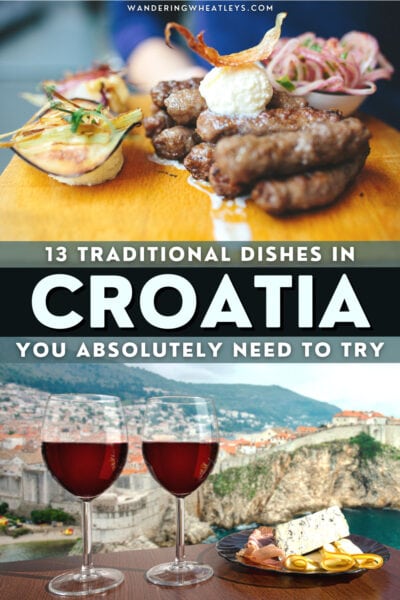
The smell of freshly salted sardines carries on Mediterranean winds as you enjoy a glass of Croatia’s finest Plavac Mali wine in an Old Town harbor on the Dalmatian coast. Chefs are busy slow cooking braised beef pašticada , while a fish stew simmers away in an iron hot pot buried under hot coals.
Croatian food is a bountiful blur of Mediterranean, Balkan, and Central European cuisines, and you’re going to love every bite and morsel of meat, fish, and vegetables that you dig into during your trip. Traditional Croatian food reflects the country’s location at the crossroads of nations, and you’ll find a delectable variety of dishes ranging from Ottoman-inspired ć evapčići to Italian-influenced pasta and gnocchi.
There are high-end restaurants and Michelin-starred chefs cooking up gourmet Croatian cuisine in tourist hotspots like Dubrovnik and Split , while in the villages and on the islands, you’ll quickly fall for the local taverna culture (known as konobas ) where fresh home-cooked food is always on the menu.
With so many things to eat and drink, you might not know what to choose from the menu. That’s why we decided to compile our list of traditional Croatian foods for you. Give these delicious Croatian dishes a try, and there’s no doubt you’ll have an incredible time eating your way around Croatia !
Disclaimer: This post may contain affiliate links. If you make a purchase or booking through one of our links we may earn a small commission (don’t worry, it’s at no extra cost to you).
13 Traditional Croatian Dishes to Try (and Where to Try Them!)
1. take a big bite of a burek.
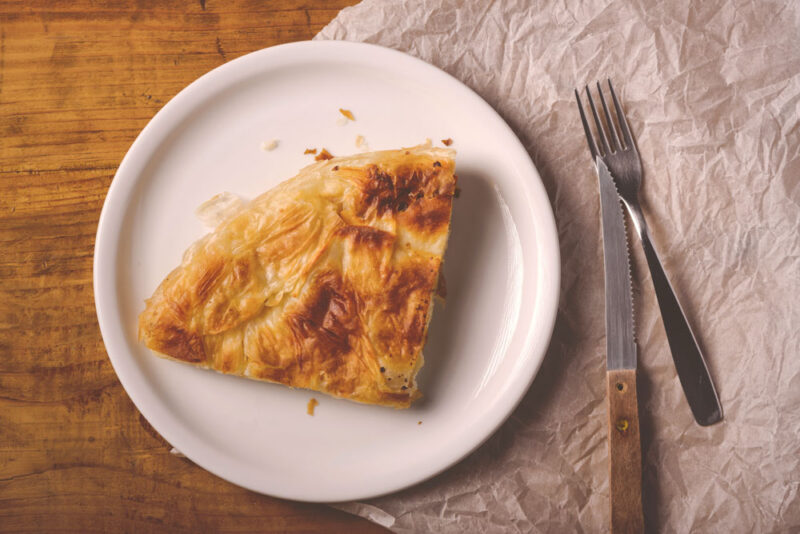
One of the most popular traditional Croatian dishes is the burek , a cheese-filled pastry that’s dripping in grease but guaranteed to leave you feeling full. The humble burek is best described as a staple, and you’ll become very used to starting your day with a hearty slice of this delicious pie-like dish when you’re traveling around Croatia.
Bureks are prepared with a thick casing of filo pastry, which flakes and crumbles beautifully when it’s been baked to perfection. In between the pastry, you’ll find a juicy selection of fillings. Cheese is the most common, but almost as popular are spinach or meat fillings. You’ll recognize a burek from the smell of the pastry, and you’ll be able to purchase them from bakeries and supermarkets all across the country.
They’re all prepared slightly differently, though, and we aren’t just talking about the recipes but the shape of the burek . You might see square or rectangular bureks ; circular, pie-like shapes are also common, while the spiral burek really is a masterpiece of baking.
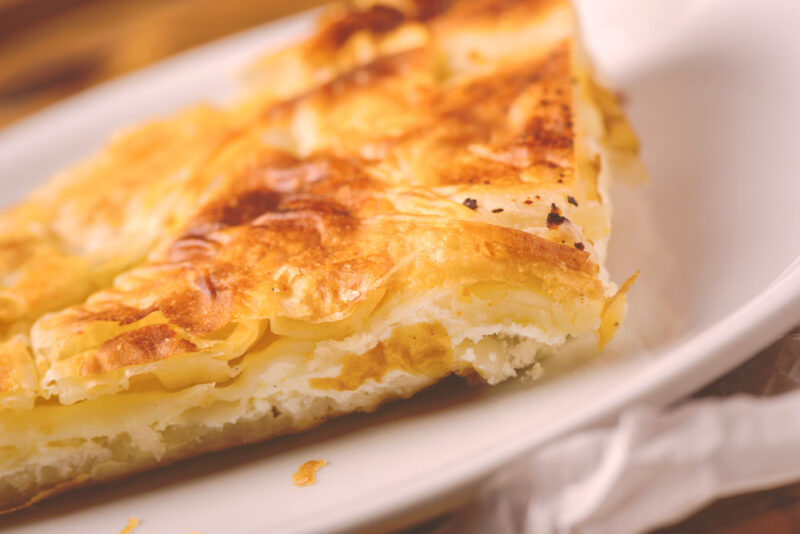
The origins of the burek are just as interesting as the shapes and fillings you’ll discover. The story goes back to the days of the Ottoman Empire when Croatia was invaded and occupied. The Ottomans brought bureks with them to the Balkans, where they stayed, and today, you can enjoy this savory treat from Zagreb to Istanbul.
The burek is a popular breakfast item, but as a savory pastry, it’s a highly versatile type of food. You can eat it for lunch, dinner, or just as a snack, and they’re excellent if you’re in a hurry or need to pack a hearty takeaway for a long hike or a long-distance bus ride. You can find bureks everywhere (we’re not exaggerating), but one popular country-wide bakery chain that always serves quality pies is Bas Burek.
2. Learn How to Stew a Seafood Buzara
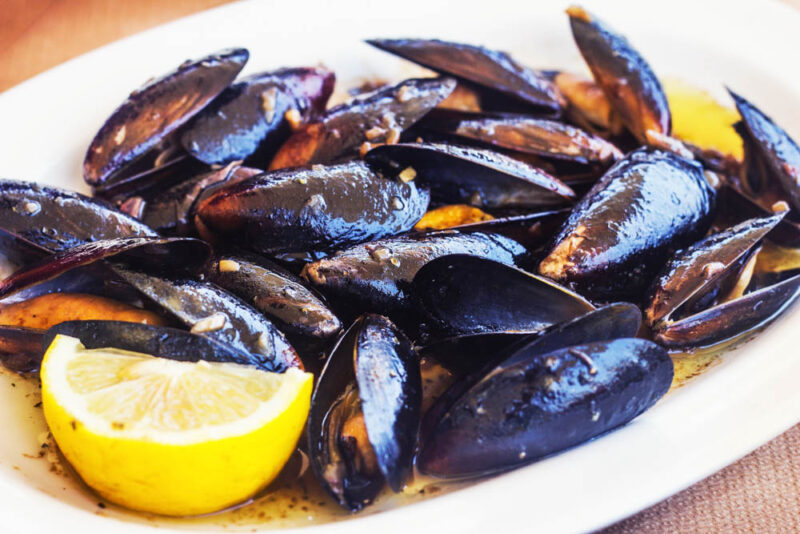
Croatia’s Adriatic coastline is beautiful, but as much as we love the turquoise waters and rugged islands, it’s the cooking that really gets us excited. Along the coast, you’ll find restaurants preparing a delectable seafood stew named buzara , which seafood fans will quickly develop a serious appetite for.
Buzara isn’t a dish as much as it is a way of cooking or preparing seafood. The word buzara is thought to have been derived from the name of the large pots Mediterranean fishermen would use to stew their catch and the endless debates between Italians and Croatians as to which side of the Adriatic developed the technique first.
First, select your seafood, with mussels, prawns, crabs, or scampi being some of the most popular options. Next, you need to stew the seafood in a sauce of olive oil, wine, parsley, garlic, and breadcrumbs. You also need to decide if you’d like a red or white buzara .
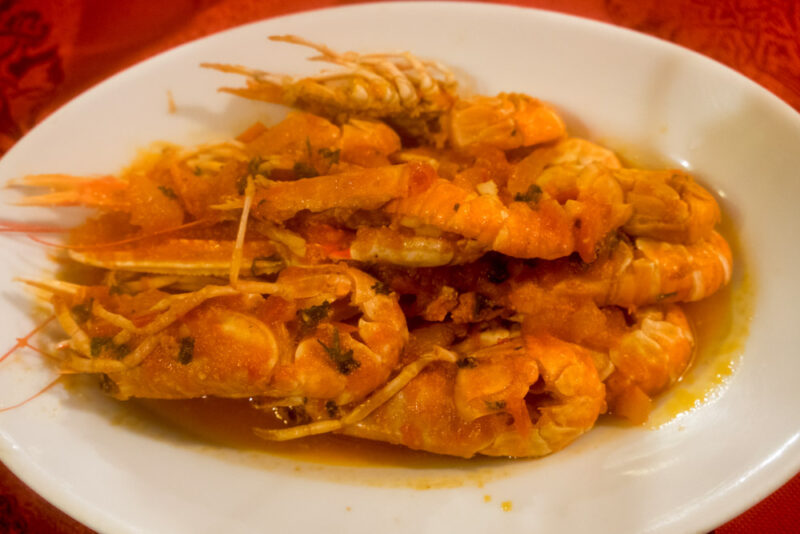
White buzara is the recipe outlined above, with white wine being the first choice. Red buzara is prepared with the addition of fresh tomatoes or tomato puree, which gives the finished dish a thicker texture and a hearty red color. Of course, you can make red buzara even more distinctive (and much redder) by pouring a healthy serving of red wine on the side and into the stew.
The Adriatic is the spiritual home of buzara , and you’ll find excellent places to try it in destinations like Split and Dubrovnik . In Split, we recommend visiting Villa Spiza in the Old Town, and in Dubrovnik, we suggest Konoba Bonaca .
3. Enjoy a Medley of Seafood and Spices with Brudet
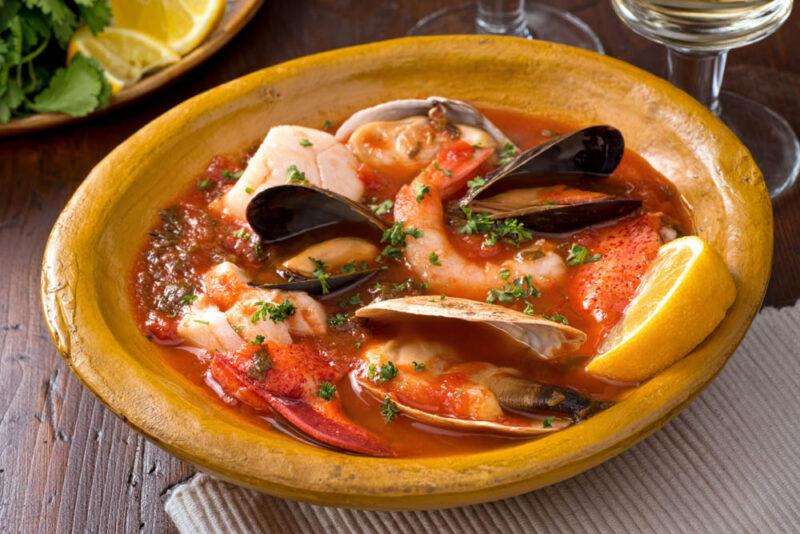
A simple, typical Croatian food you’ll find along the coast is named brudet , and it’s a delicious medley of seafood and vegetables stewed in wine and spices.
Brudet is a one-pot meal, and like buzara , you’ll find variations of this dish all across the Adriatic Sea. Italians also claim it as their own, as do Montenegrins and Croatians. In Croatia, the dish is a mouthwatering Adriatic specialty, and it’s best when prepared with multiple types of seafood.
The seafood itself varies from region to region and catch to catch. Whatever’s available can be thrown into the pot, and it’s not uncommon to find brudet prepared with a mix of fish and shellfish (some chefs will tell you that three different types of fish are the minimum required for a brudet ). To this seafood delight are added seasonal vegetables, while the sauce is prepared using olive oil, garlic, parsley, onions, tomatoes, vinegar, and wine.
Leave everything to slowly stew in the pot, giving you a thick sauce that’s perfect for mopping up with polenta or bread. Kvarner, Dalmatia, and Istria are all well-known for their brudet . In Rijeka, a port city overlooking Kvarner Bay, you’ll find excellent brudet at Konoba Tarsa , a local tavern serving up hearty stews.
4. Savor the Salty, Smokey Taste of Pršut
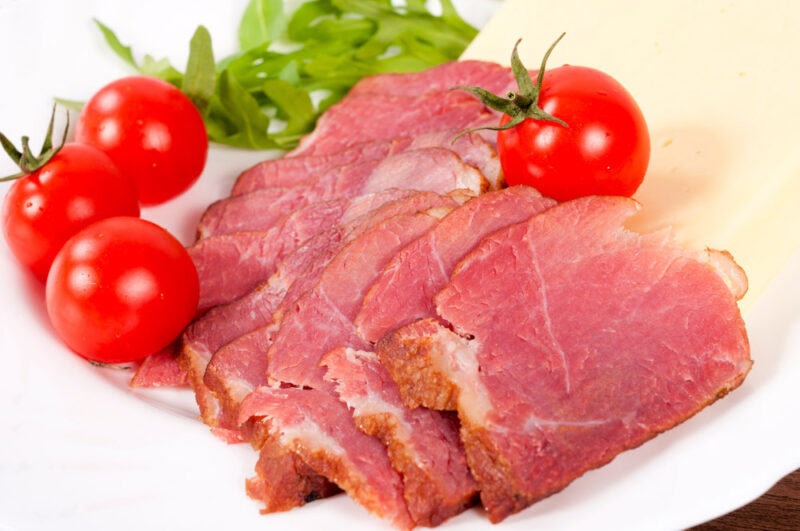
Croatians love their cured meats, but none has quite so much allure as the salty cuts of dried ham known simply as pršut . This Croatian delicacy takes weeks to properly prepare and cure, but the results are absolutely worth the wait. You’ll soon be figuring out ways to ship entire legs of pršut home as you near the end of your vacation.
Pršut is very similar to Italian prosciutto. Pork thighs are heavily salted, then left to dry in the salty sea wind that whips down the Croatian coastline. Pršut might be further pressed with heavy weights to remove excess moisture, and it’s often smoked over wood-burning fires to add a uniquely smoky tang to the finished product.
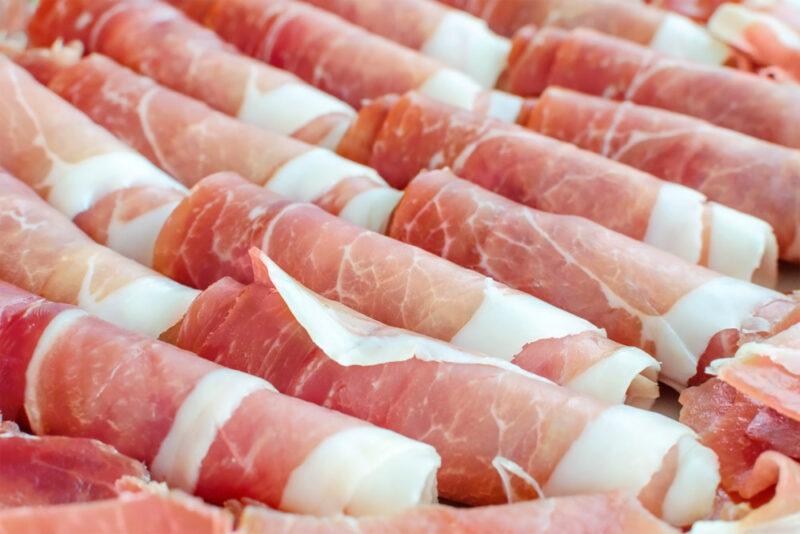
Different regions have preferred methods of preparation. In Istria, for example, pršut is typically dried by the sea (smoking is rare), while Dalmatians focus on smoking their pršut . When ready (some producers might cure pršut for as long as a year), the pršut is sliced super thin, then served alongside olives, cheese, or melon. For the best Istrian-style pršut , head to Kod Milana Estate near Pula.
5. Get Festive with Croatian Fritule
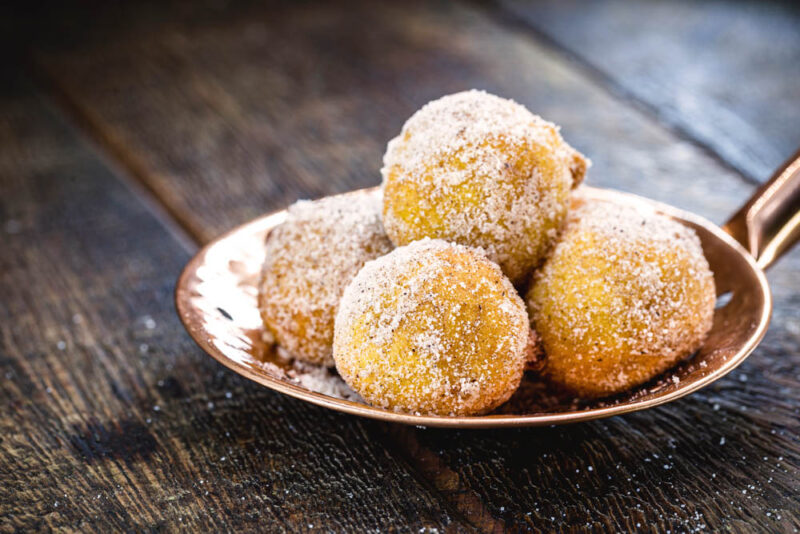
As soon as the festive season begins, you’ll smell the sweet scent of fried doughnuts wafting through Croatian streets. That sweet scent is fritule , and when you smell it, you know it’s Christmastime in Croatia.
A fritule is a small doughnut-like pastry typically served with powdered sugar or icing sugar after being deep-fried in oil. They’re deep-fried quickly, leaving them super crispy on the outside but lovely and soft when you bite into the middle.
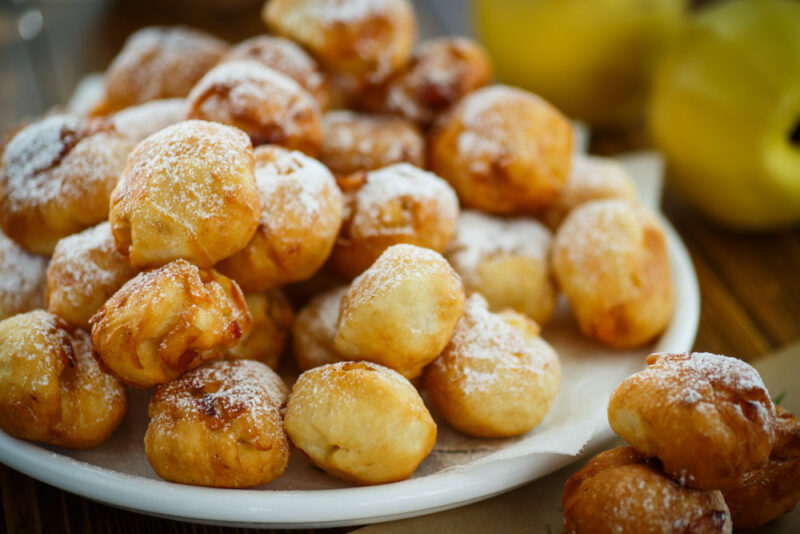
Traditionally, fritule are prepared during Advent, when Croatians are counting down the days before Christmas begins. Basic fritule are made using a pancake-like mixture, but every region has its own recipe. You might find fritule made with raisins or lemon zest or with dough that’s doused in rum before being fried.
These traditional recipes are often expanded upon with the addition of delightful extras such as chocolate sauce, caramel, or ice cream, making them an excellent choice of dessert in the run-up to Christmas. You’ll find them at Christmas markets all over the country, but we recommend traveling to Zagreb, the capital, where you can sample the best fritule in Croatia.
6. Brave Crni Rižot, Croatia’s Famous Black Risotto
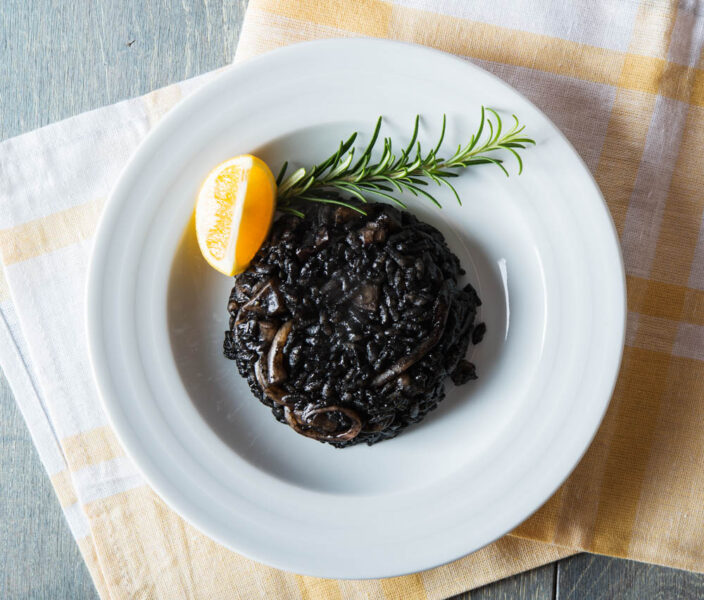
One of Croatia’s most distinctive dishes is crni rižot , the nation’s famous black risotto. This is one of our favorite things to eat in Croatia, not least because of its unusual color.
Crni rižot is a jet-black risotto that’s best prepared using fresh seafood straight from the harbors of the Adriatic Sea. You’ll need risotto rice, garlic, onions, parsley, and olive oil, while the unique darkness of the dish comes from sacks of squid ink pivotal to its preparation.
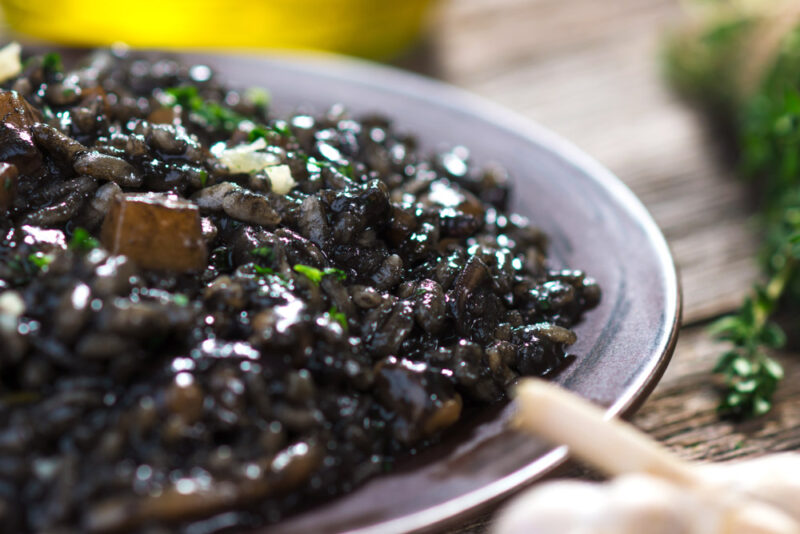
Chefs will remove the sacks directly from the squid, the tentacles and body of which are then sliced up and also used in the cooking process. The risotto rice is slow-cooked in a mixture of fish stock, white wine, and squid ink, leaving you with a delectable main course that’s best enjoyed with a glass of white Croatian wine.
Of course, the best crni rižot is always found along Croatia’s coastline. It’s popular from north to south, and you can find it everywhere from Rijeka down to Dubrovnik. Try the crni rižot at Orhan , a restaurant located in Dubrovnik, or if you’re in Split, try Konoba Fetivi .
7. Treat Yourself to a Mouthwatering Ćevapčići
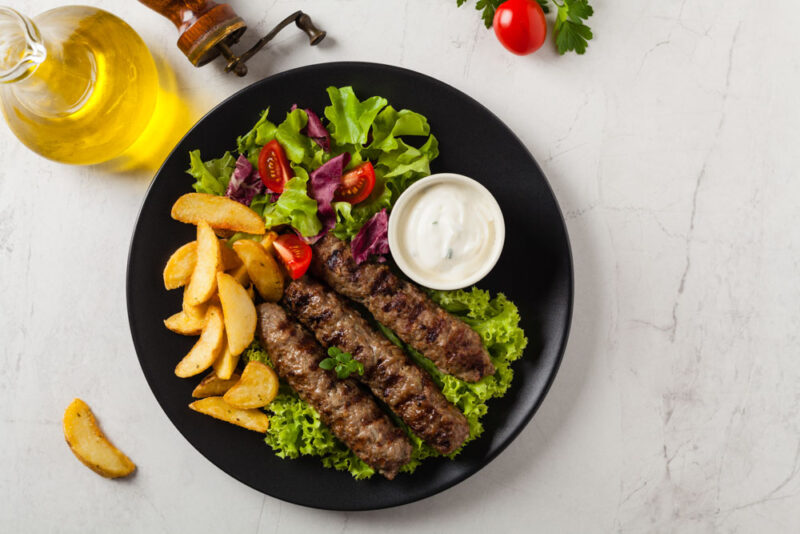
Ćevapčići (or cevapi ) is one of the most widespread dishes in the Balkans. Like the burek , this is a dish that was popularized during the Ottoman era and has now become a regional staple.
Ćevapčići is a meat-heavy dish consisting of minced meat seasoned with salt and spices. It’s then molded into a kebab or sausage-like shape around a skewer. The meat varies but is often beef, pork, veal, or a mix.
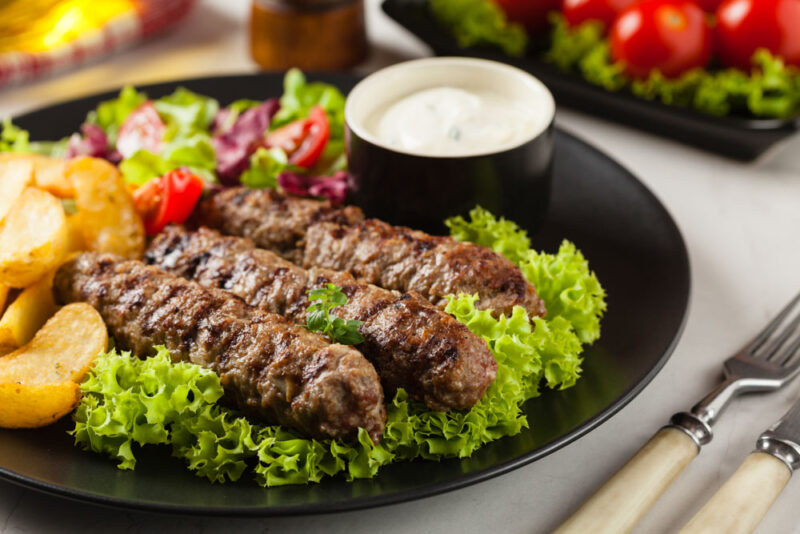
The best ć evapčići is grilled over hot coals and served dripping with grease. Once the meat is cooked, it’s usually served with thick slices of flatbread, or it could be dished up as a part of a meat platter with rice and salad on the side. It’s always accompanied by a hot paprika sauce named ajvar .
As it is for Serbians, Bosnians, Montenegrins, and North Macedonians, ćevapčići is a big deal for Croatians. That means you’ll find ćevapčići being cooked up all over the country, and it’s a favorite for takeaways. Travel to Zagreb for excellent ćevapčići , where you can try local favorites like PLAC Kitchen & Grill or MS Grill.
8. Wait Patiently for Pašticada
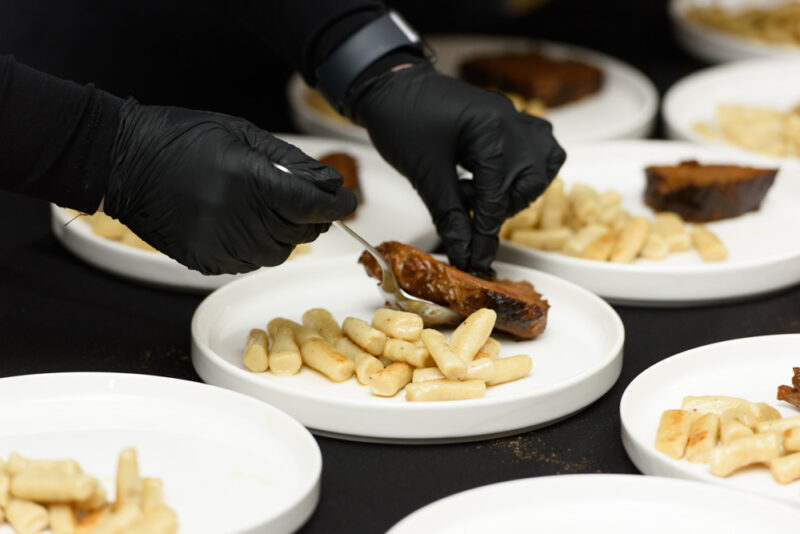
If you love beef, then look no further than pašticada , a saucy beef dish that takes hours to properly prepare.
Pašticada is the ultimate Croatian beef stew. The dish calls for an entire round of beef, which is first stuffed to bursting with an assortment of herbs that give the stew its deep flavor. This includes onions, parsley, garlic, and cloves.
The beef is sliced open to insert the herbs, after which liberal quantities of bacon are also added for good measure. The beef is then left to marinate for hours (overnight, if possible) in a mixture of oil and vinegar.
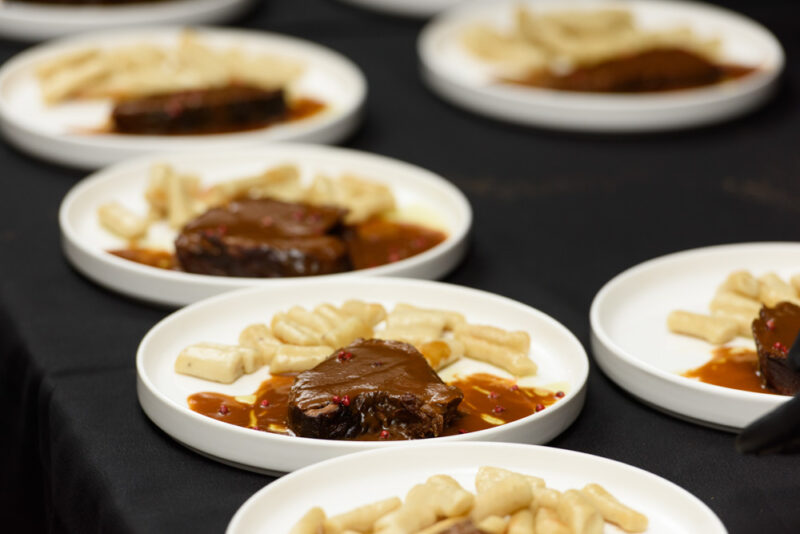
Once the beef has soaked up all that marinade and flavor, it’s first braised in a pan alongside any other vegetables (like carrots and onions) that are also going to make their way into the stew. The next step is to soak the beef and vegetables in a red wine sauce, and from there, you slowly stew the ingredients until they’re beautifully tender.
Chefs might add other ingredients to the stew at this point, too, including figs, bay leaves, and other herbs and spices. The pašticada is then served with a juicy covering of sauce alongside a traditional side of gnocchi.
Pašticada is said to have originated in Dalmatia, where the oldest recipe found to date was discovered in Dubrovnik. That’s the place to order it, and we suggest visiting Konoba Veranda by Dubrovnik’s seafront.
9. Cook a One-Pot Ispod Peke Under Hot Coals
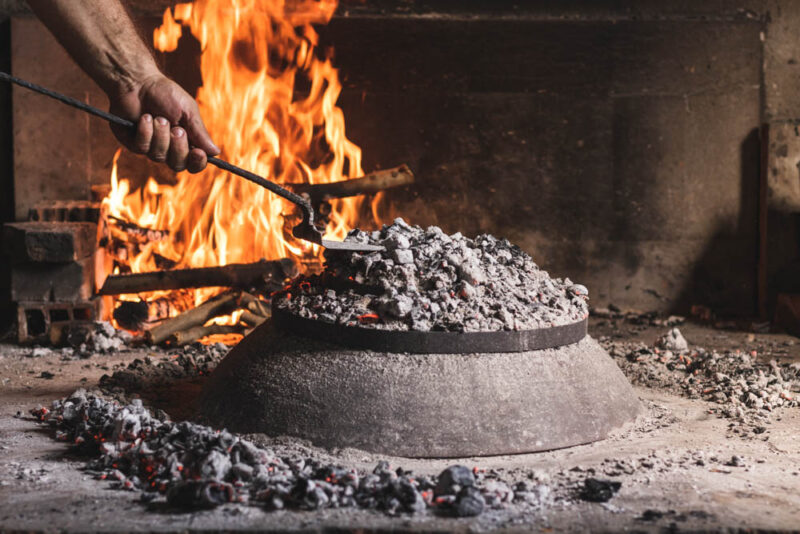
Ispod peke (also called ispod cripjne ) is a traditional Croatian food that’s thought to date back centuries. Specifically, ispod peke is really a style of cooking, as the name translates into English as “cooking under the lid.”
The “lid” in reference is a cast iron cooking pot that’s filled with meat, fish, or vegetables before being buried beneath hot coals that envelop the dish with heat. The one-pot meal is then left to slowly cook in the coals until the ingredients inside are stewed to perfection. It’s an ancient cooking process – one that’s thought to have been used in Croatia since Roman times.
To start, you’ll need your cast iron pot and an open fire pit or large oven for heating coals. Next, you choose from fish (octopus is popular) or meat (veal is an excellent choice) and throw them into the pot, which will already be lined with chopped potatoes, carrots, onion, and garlic. Pour in olive oil, add bay leaves and rosemary, and top up the stew with a nice serving of white wine. Cover the pot, and bury it in the coals to cook.
Some of the best ispod peke is found in Split, Dubrovnik, and on the Croatian islands, where octopus and other seafood are a favorite ingredient. In Split, try Konoba Varos for authentic ispod peke .
10. Head to Slavonia for Spicy Fiš Paprikaš
Croatian cuisine tends to be focused on the coastline, where there’s an abundance of fresh seafood, but don’t ignore the delectable offerings inland, where you can also find delicious fish-based dishes.
In the historical region of Slavonia in northeast Croatia, one such specialty is fiš paprikaš . As you’ll be far from the coast, this dish makes use of freshwater fish from the region’s rivers, including the likes of catfish and perch.
Fiš paprikaš is best described as a spicy fish stew. You’ll need onions, white wine, garlic, and lots of spicy paprika to make the broth, in which your freshwater fish is stewed until tender. You can stew the fiš paprikaš in an oven, where it’s often cooked alongside potatoes and other vegetables. It’s also common for the fiš paprikaš to be served with noodles and, of course, a glass of wine to take the edge off the spice.
Make your way to Slavonia for the best fiš paprikaš . In Osijek, the regional capital, we recommend visiting the riverside restaurant Kod Javora .
11. Try Istrian Raw Fish, Croatia’s Take on Sushi
If you believe that the Japanese are the only nation to savor the delights of raw fish, then you’d be wrong. Istrians have been preparing a type of raw fish for generations, and in Novigrad-Cittanova, the delicacy is best enjoyed at a restaurant named Damir & Ornella .
The preparation of Istrian raw fish is an art that goes back centuries, although, we’ll be clear, it’s very different from Japanese sushi. Damir & Ornella are the masters of “Istrian sashimi,” and you’ll love how they serve their raw fish delicacies with skill, flair, and simple flavor.
Their menu is a fine example of the art of Istrian raw fish, and the restaurant is the best place to get a taste of local specialties, including raw Kvarner shrimp. The shrimp are served fresh from the Adriatic Sea with a side of melon and a drizzle of olive oil.
Of course, they go down particularly well with a glass of white wine. The classic dish is raw fish served with olive oil and a portion of black truffles, then topped with some tasty polenta to finish. Again, it’s best enjoyed with a glass of white wine from a local Istrian winery.
They also serve scallops in a buttery sauce, white scallops mixed with pepper, fresh crabs with balsamic vinegar, and Istrian favorites like pasta and gnocchi (served with seafood, of course). Then you can finish off your meal with homemade ice cream served with a drizzle of olive oil (yes, it is unique!).
12. Snack on Salty Croatian Sardines
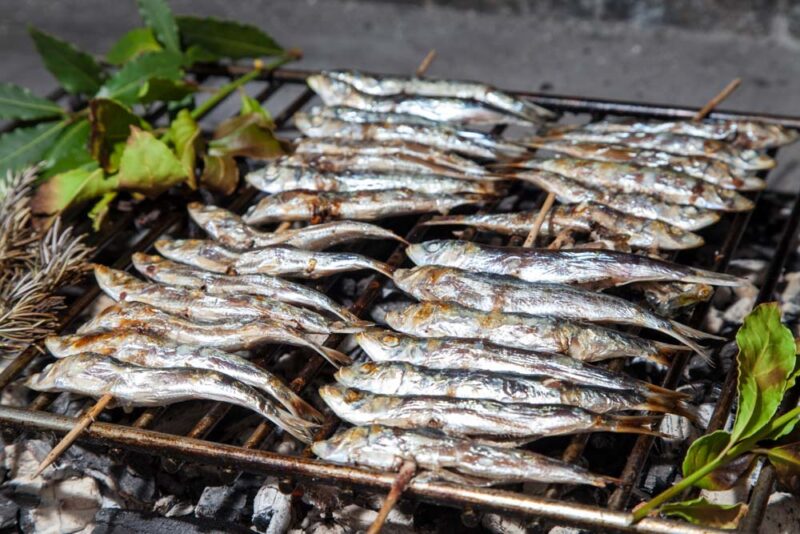
One of the most popular types of Croatian seafood is the humble sardine, which you’ll find is a highly prized catch along the country’s long coastline.
Croatian sardines are dripping in fatty acids, oils, and Omega-3, and they’re consumed by the netload for their health-imbibing qualities and their salty taste. There are innumerable ways for Croatian sardines to be prepared, and each tavern and restaurant has its own cooking styles and seasonings. They can be grilled over hot coals, barbecued outdoors, or baked to perfection in the oven.
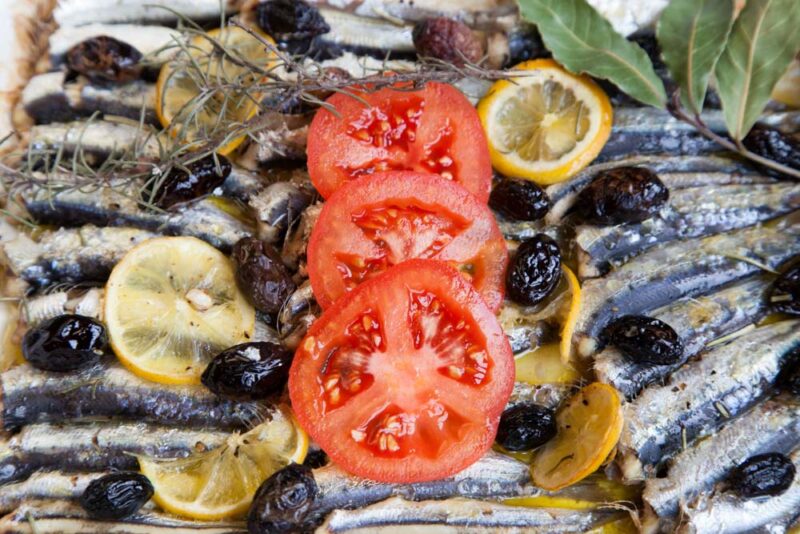
One specific sardine delicacy that’s enjoyed in Croatia is the slane srdele , which is historically only prepared during the summer months. Freshly caught sardines are smothered in salt and then packed tightly into barrels.
More salt is added until the sardines are covered, and the barrels are then left, pressed down by weights, for at least three months. It’s a way to save the sardines caught in summer for winter, and the salty preserved fish is a true delight. You’ll find sardines all along the coast, but the Zardar region is particularly known for its high-quality fish.
13. Enjoy a Glass of Croatian Wine
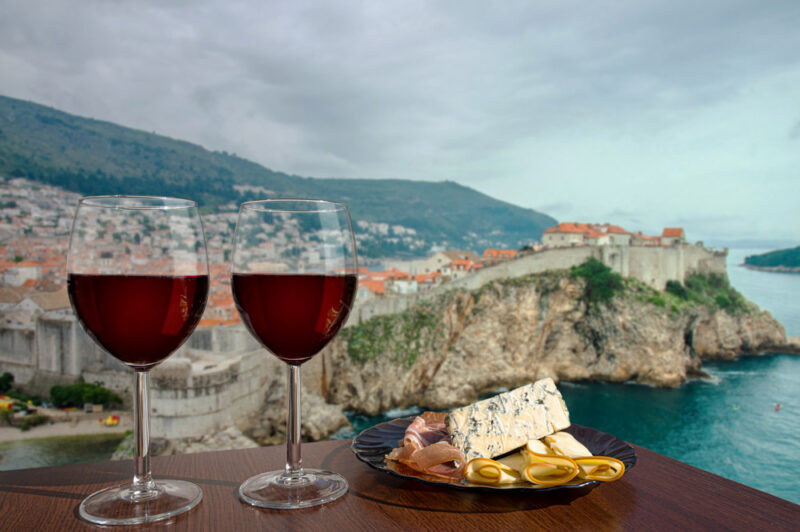
You’ll have ample time to try Croatian wine during your stay in the country, and you’ll quickly fall in love with the nation’s finest vintages. Croatian wine isn’t particularly well-known outside of the country, but trust us when we say the grapes grown here can compete with anywhere else in the Mediterranean. After all, Croatia has a climate and soil that’s been producing excellent wine since the Roman era.
The most popular variety of red wine comes from grapes grown along the Dalmatian coast. Named Plavac Mali, it’s a fruity wine that goes well with a seafood stew. Posip is a type of white wine that was traditionally grown only on the Croatian island of Korcula but has now spread across much of the Croatian islands and to the Dalmatian mainland.
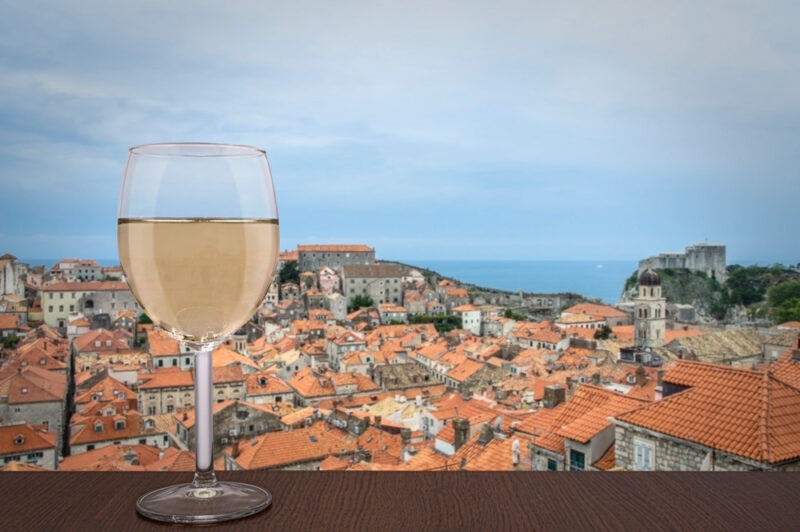
In other areas, there are more wines distinct to Istria, while the upland region of Slavonia produces a unique variety that’s shaped by the higher altitude and inland climate.
There you have it! The 13 best traditional Croatian foods to try on your next trip. What’s your favorite traditional Croatian food?
Share this on pinterest.
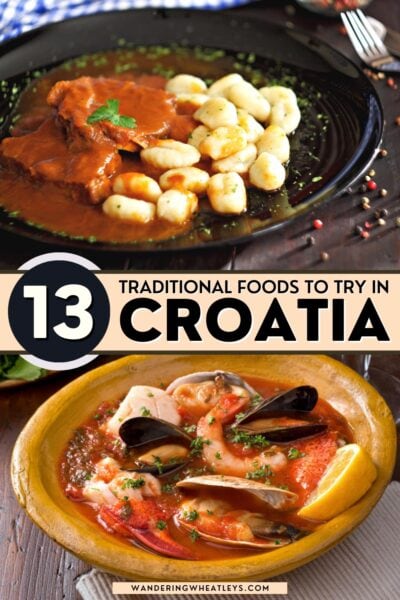
About the Author:

Richard is an award-winning travel writer based in Southwest England who’s addicted to traveling off the beaten track. He’s traveled to 75 countries and counting in search of intriguing stories, unusual destinations, and cultural curiosities. Richard loves traveling the long way round over land and sea, and you’ll find him visiting quirky micronations and breakaway territories as often as he’s found lounging on a beach (which is a lot). When he’s not writing for BBC Travel, National Geographic, or Lonely Planet, you can find Richard writing for the Wandering Wheatleys or updating his off-beat travel blog, Travel Tramp.
View all posts
Related Posts
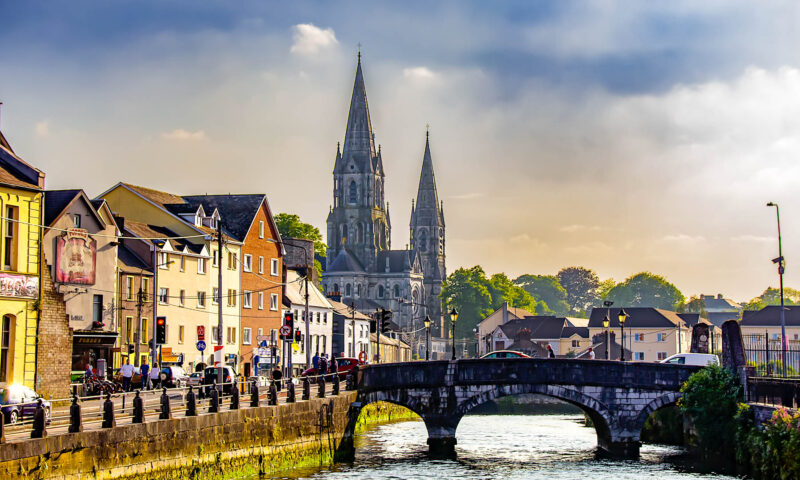
The 12 Best Boutique Hotels in Cork, Ireland
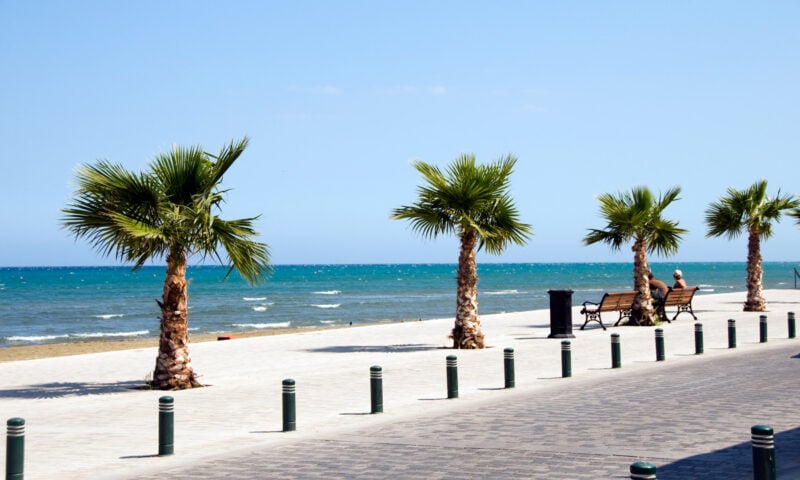
The 13 Best Places to Visit in Europe in March (2025)

The 25 Best Things to do in Greece
Leave a comment cancel reply.
Your email address will not be published. Required fields are marked *
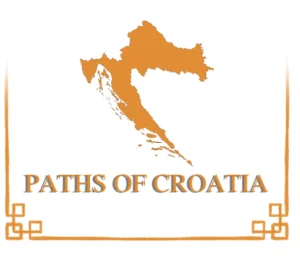
A Beginner’s Guide to Croatian Cuisine (With 20 Famous Dishes to Try)
Croatia is home to an interesting and rich cuisine with famous dishes that win hearts.
I decided to create a beginner’s guide to Croatian cuisine, so I can explain what food you can find in different regions of Croatia!
Just for the record, some of the food I am about to mention is dangerously delicious, so don’t forget to eat before reading this!
What is Croatian food like?
Croatian food ranges from seafood to meat dishes with lots of vegetables and both the Mediterranean and continental spices popular in Balkan.
What’s awesome about Croatian food is that by traveling through the state you’ll always find something new, usually equally delicious!
I understand that people have preferences, someone falls for seafood, while someone likes plenty of carbs and red meat, but don’t worry there’s something delicious for everyone.
It is possible to categorize Croatian cuisine per region, so I’ll name the most popular dishes you can find and say a few words to describe them.
This way, you’ll know exactly what you are looking for next time you plan a trip here. I’ll start from the sea and coast and then cover the continental region.
Coastline food
Sea and meat dishes can be found along the entire Croatian coastline from Istria to Kvarner and Dalmatia and on the islands, so let’s see what there is!
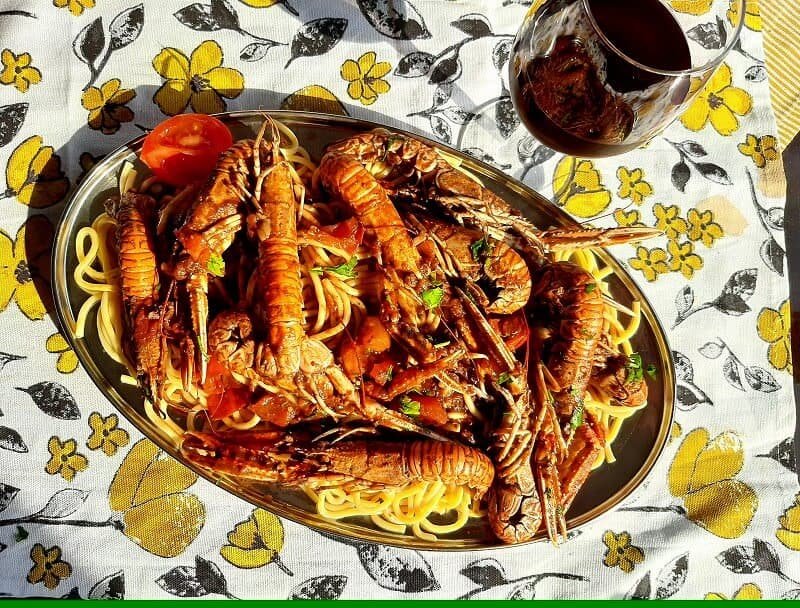
Buzara is traditionally made from prawns, but it’s not unusual to find Buzara made from mussels and shrimp.
This famous sea dish is super simple yet fresh seafood is necessary. Prawns, olive oil, garlic, tomato, and wine is all you need to make the buzara worthy of the kings.
I won’t ever forget the smell this dish makes in the kitchen, as when I first discovered it as a child I would intentionally spend time in the kitchen just enjoying the wonderful smells in anticipation before I could put my hands on it.
Forget about the fork and a knife, true buzara is enjoyed bear handed as you’ll need to reach the meat between the shells. You’ll be served some warm water with lemon juice to wash your hands afterward, don’t worry!
Buzara is enjoyed for its amazing and fancy flavors, but with enough carbs such as pasta, you won’t end up hungry.
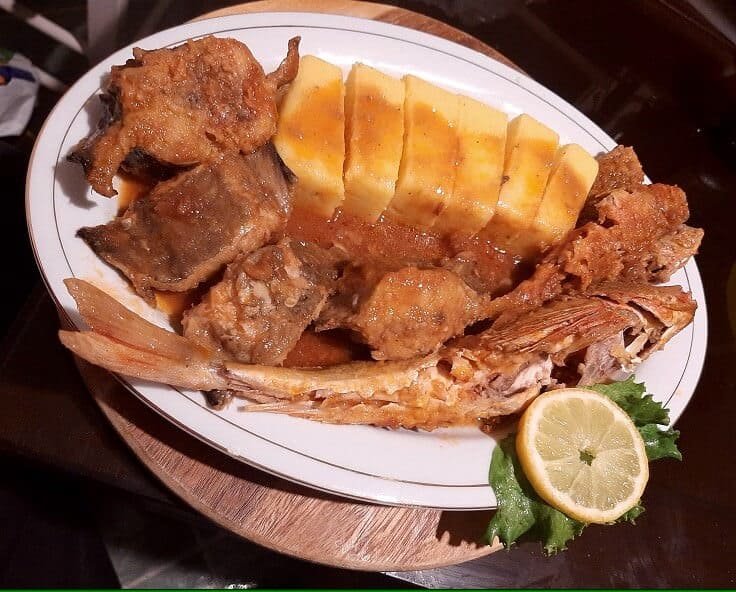
There is a saying, a good brudet is measured by how many fish varieties are in it.
Brudet is always made from various fish such as conger eel, scorpionfishes, and sharks and served with carbs such as polenta ( cro . palenta ), or pasta and potatoes in the lack of polenta.
A traditional way to serve brudet is with polenta, the corn flour porridge. Pair it with some green salad and white wine and you have the sea dish you won’t forget for a lifetime.
It’s possible that you won’t eat the same brudet twice, as there are so many possibilities when it comes to tweaking the recipe, but it’s so tasty that you’ll enjoy it every time as long as the cooks are not cheap on fish.
Brudet is one of those dishes that win your heart and engrave the good memories in your mind of spending time by the coastline or on islands of the mediterranean sea.
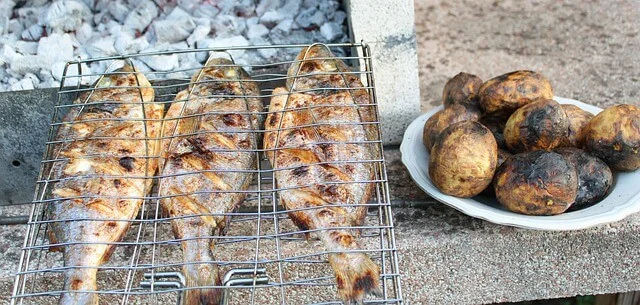
Gradele dish is any fish or vegetables traditionally prepared on a grill.
Gradele is a traditional Croatian method of cooking and you’ll find many lovely dishes made this way.
What makes this grill special is the process and ingredients used.
First, the fish is put on a grill placed above the embers, then for the whole duration of grilling the fish is oiled with extra virgin olive oil and parsley.
Once the fish is cooked, more olive oil, garlic, parsley, salt, and pepper are added.
Traditionally, Gradele is always enjoyed with fine wine which makes the experience complete.
The fish swims 3 times, once in the sea, second in the oil, and third time in the wine. The old Dalmatian saying
Crni rižot (Black risotto)
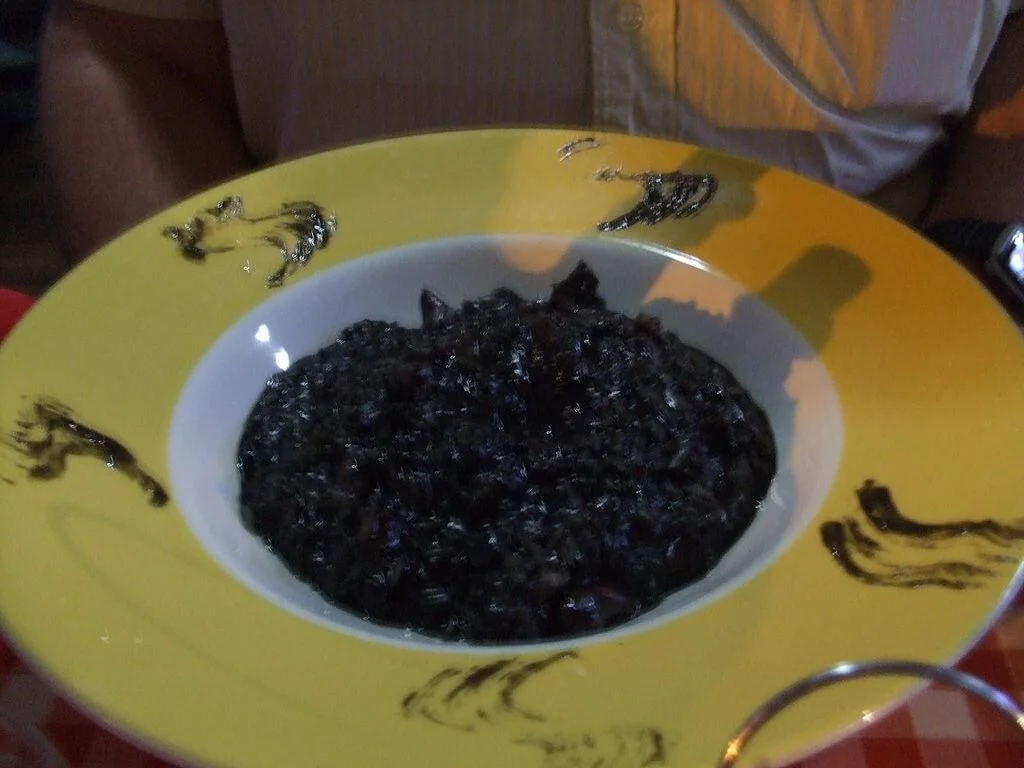
Crni rižot is a sea dish prepared with squid and rice, typically served with a salad and white wine.
This delicious dish doesn’t only taste different than any other sea dish but also looks completely different and somewhat extravagant.
The black color comes from squid ink, but it’s not just about the color, the squid ink provides a beautiful texture to the rice and a strong aroma.
If you are looking to try something different you never tried before, put crni rižot on the list.
Salata od hobotnice (Octopus salad)
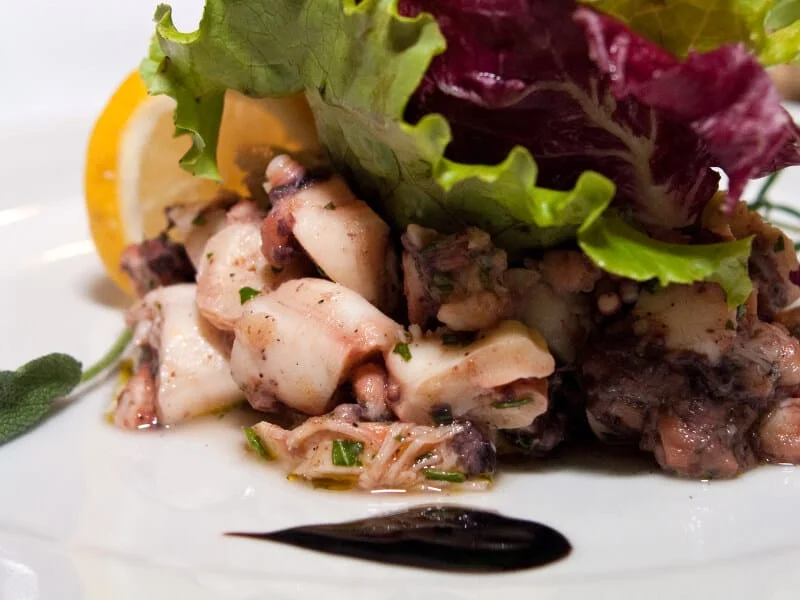
Octopus salad is a delicious dish made from cooked octopus chopped into small pieces, potato, onions, parsley, olive oil, and seasoned with salt, pepper, and lemon juice.
This dish is enjoyed cold and served as an appetizer or a light dish that won’t overwhelm you while it will reveal the rich cuisine of Croatian coastal areas.
Although I love Octopus salad, in my opinion, the Octopus under the bell is the epitome of Croatian coastline cuisine as that perfection can hardly be beaten.
Jela ispod peke (food under the bell)
Jela ispod peke is a traditional Croatian method of preparing delicious dishes by cooking in a bell-shaped dome surrounded by a bed of hot coals and wood.
This way, the temperature can get extremely hot and the meat and vegetables will be cooked evenly and infused with smoky flavors during slow cooking which can take several hours.

Jela ispod peke consists of various types of meat such as lamb, beef, and veal, seafood like monkfish and octopus, and vegetables, while it is common to season dishes with herbs like thyme, rosemary, garlic, and onions.
Moreover, it’s also common to find traditional Dalmatian bread prepared under the bell.
My favorite dish under the bell is the lamb with potatoes, and vegetables such as onions and carrots, and I can vouch that no quick, restaurant cooking methods will result in such evenly cooked, smoked, and juicy meat as when it’s cooked under the bell.
When I was young I used to participate in big family gatherings around Peka, and while it always takes hours for Peka to be done, it was worth it every time.
Jela ispod peke isn’t an everyday thing in restaurants but rather a specialty only some restaurants offer, so if you catch the opportunity to try Jela ispod peke don’t miss it!
Pršut (Croatian prosciutto)
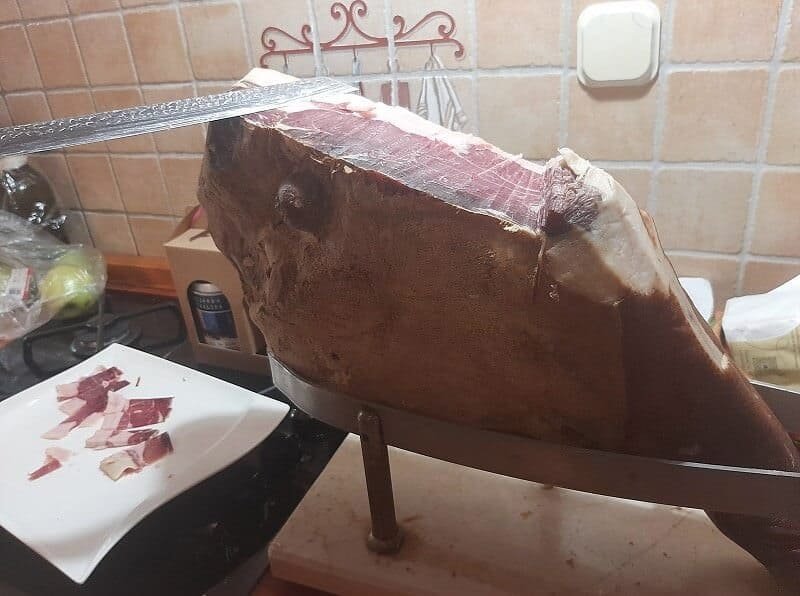
If you are a fan of pršut, you’ll find Croatian pršut among the best you ever had.
While many claim there’s no pršut like Dalmatinski anywhere else in the world, many also praise the Istrian pršut and for the politeness, I must give a shoutout to the Italian prosciutto too.
Let’s begin with the Dalmation pršut, you’ll know what makes it special after taking the first bite as the smokey flavors trapped within a great balance of dried meat and fat will dissolve on your palate.
Damaltinski pršut is unique because only the high-quality meat along with the skin and fat is salted, then dried on the notorious Croatian wind called bura for 2 months, smoked for 2 months, and eventually aged for at least 12 months to produce the unique masterpiece of Dalmatian cuisine.
Istarski pršut on other hand isn’t made with skin and fat and the smoking part is excluded.
Nevertheless, it tastes amazing and has similarities with Italian pršut.
There are also Krčki pršuti (from the island of Krk) which fall somewhere between Dalmatian and Istrian styles and all named pršuti are registered as indigenous national products.
Every pršut unique to the region tastes different and has its own perks, so the point of the story is that if you like dry, salty pršut with a strong smokey flavor the greatest type of such pršut is found in Dalmatia but sweeter, less smokey variations can be found elsewhere such in Istria or Krk.
Creska janjetina (Cres Lamb Dish)
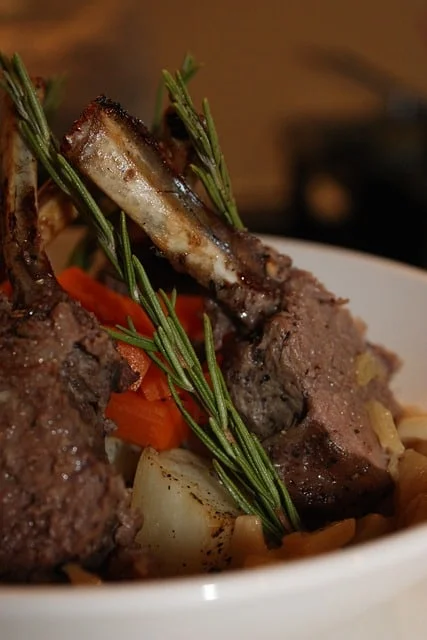
If there is one iconic dish I could highlight that origins from the Kvarner area I’d pick out the one and only, Creska janjetina.
This dish is prepared on the island of Cres, and due to the fact that it’s super easy to visit Cres from Rijeka, this dish is absolutely unavoidable.
Creska janjetina is a favorite among the locals, as it’s easy to spot the quality of the Croatian lamb from the lamb that is mass-produced in countries such as New Zealand or other states it gets exported from.
It’s said that the lambs that populate the island of Cres, enjoy the variety of vegetables that are found in the preserved nature far away from the influence of dirt, and air pollution.
After all, Cres is home to around 1100 plants, with 939 indigenous species that enrich the land like nowhere else.
It is said that there are more plant varieties found in Cres than on all lands of the UK combined.
Thus, the lamb from the Cres region tastes so juicy and sweet with unique aromas you couldn’t notice in other lamb meat.
The typical lamb dish is made from lamb, potatoes, onion, garlic, and salt but it’s not unusual to find other grilled or cooked vegetables in it.
When you only need salt from all the seasoning options to produce excellent, mouth-watering meat you know it’s something special.
Istarski fuži with boškarin and truffels
Here, I’ll focus on a famous dish that Istria is known for and as a matter of fact, this dish was the reason why I’d often travel to Istria back in the day.
Then, I learned to prepare this dish at home, so I no longer have to travel miles just to enjoy this heavenly dish.
The dish is made with Istrian pasta called fuži , which is pasta cut from a thin layer of dough in a diamond shape.
This pasta is worth comparing with other famous Italian kinds of pasta and the best of all is that fuži are freshly made in restaurants or at household instead of buying dried pasta in bulk which adds to the quality of the dish.
This alone, makes a huge difference and Istrian restaurants are keeping this tradition strong for a very long time.
Istria is rich with the finest black truffles in Europe, and when truffles are mixed with fuži, olive oil, and cheese, there are hardly any words I could use to explain the experience.
Moreover, you can also enjoy fuži with Boškarin, the cattle authentic to the region of Istria .
Boškarin can be prepared in many dishes and even in a classic salami, and it’s usually followed with spicy black pepper.
At one point in time, Boškarin was close to extinction and while it’s being populated back again, this dish is still for a reason only found in Istria which creates a certain rarity that makes Istrian cuisine special.
Istrian Maneštra (Istrian vegetable stew)
Istrian Maneštra is a traditional stew made with beans, potatoes, various vegetables, and smoked ham or bacon.
This famous Istrian stew is slow-cooked for several hours before all the flavors meld together and produce a worthy dish of the region.
Istrian Maneštra is enjoyed with locally-made crusty bread and a glass of red wine.
While this dish is ideal for cooler weather, I don’t ever say no when someone offers me some.
Continental Food
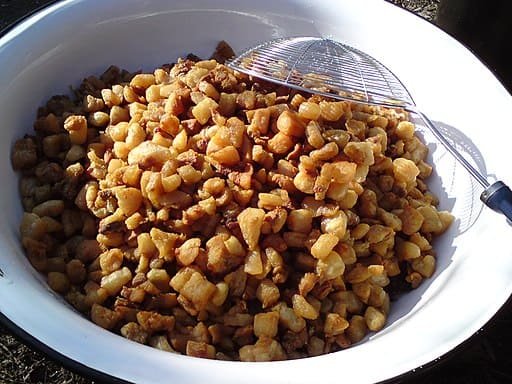
Čvarci are fried pork scratchings, and while this used to be the food of peasants hundred years ago, today it’s a sophisticated delicacy in the area of Continental Croatia.
Čvarci are great snacks and taste amazing, but they are pretty much pure fat which translates to lots of calories, so be careful not to get addicted!
For some reason, the taste of fried pork fat is hard to resist unless you are a vegan, of course.
Meso z Tiblice
This popular dish Meso z Tiblice, Međimurje is renowned for, is the fine pork meat seasoned and baked and then set in plenty of pork fat.
This dish originated as an answer to the lack of refrigerators back in the day when people would need to preserve food over the year.
One good way to preserve the meat is to put it in salt and dry it on the strong wind as it’s the case with pršut and many sausages, but the other is to trap the meat in so much fat that no contaminants could touch it.
Today, Meso z’ Tiblice is served as an appetizer when you visit Međimurje.
Bučnica (pumpkin pie)
Who can resist a pumpkin pie? I know I can’t and that’s why I can’t wait for autumn to finally arrive.
A few eggs in, some cottage cheese, butter, seasoning, cream, and pumpkin stuffed in dough can’t be resisted.
Bucnica smells just as good as it tastes and its coziness shall welcome any foreigner to Zagorje.
Bucnica is just one of the many pumpkin dishes, I personally also love pumpkin soup.
Purica s mlincima (turkey with flatbread)
Purica s mlincima will evoke emotions Americans hold on a Thanksgiving as it’s pretty similar to it but is prepared in a different, traditional way.
While you’ll find purica (turkey) to be prepared in a similar fashion as you’d find in other cuisines, mlinci are something unique to Croatia.
Mlinci is a thin, dried dough made of flour, salt, and water which are later poured over with boiling water and meat juice.
The result is an untypical, juice pasta with an interesting texture that melts in the mouth.
Purica s mlincima is served everywhere in Croatia during holidays but is an especially popular dish in continental Croatia.
Slavonski Čobanac
Made from at least 3 types of meat such as beef, pork, and chicken with some vegetables and noticeable addition of spices such as strong, red paprika (consider this something close to chili as it’s similarly spicy).
Slavonski Čobanac is traditionally cooked outside in a big kettle that can hold gallons as a dish that takes more than 3 hours to complete isn’t worth making in small quantities.
Slavonski Čobanac is a traditional dish that would be prepared for big families and guests on special occasions and then people would proceed to enjoy wine and play traditional instruments such as tamburica and harmonika.
This is a phenomenal dish you can’t miss if you ever pay Slavonija a visit!
Fiš paprikaš
Fiš paprikaš is a delicious dish made from at least 2 types of freshwater fish such as catfish and carp, Slavonian dry red paprika, and wine served with noodles.
This dish can be bitter and sweet, full of glorious aroma, and nutritious.
Fiš paprikaš is among my favorite continental Croatian dishes and it goes so well with local white wine, so if you are keen on freshwater fish dishes give it a try.
Kulen (spicy sausage)
They call it the King of all Croatian sausages, the one and only, Slavonian Kulen.
Kulen is a smoked, spicy pork sausage known for its strong and distinctive red color and spicy, meaty taste with plenty of influence of red paprika and garlic.
Kulen is a very clean sausage made from quality meat and it takes lots of finesse to produce such a masterful sausage.
Slavonia is full of rich and flavorful food products and dishes and if you are a fan of sausages you can’t miss it.
Popular croatian desserts
Fritule (sweet pastry balls).

Fritula, the sweet pastry balls made from flour, eggs, sugar, milk, raisins, and sometimes an addition of rakija or rum for flavor are the ideal street-food treats.
Fritula is fried in hot oil until they become golden brown, then is dusted with powdered sugar and served warm.
Fritula is a popular treat during the holiday season, particularly around Carnival Time and Christmas when you can find them at every corner in Croatian towns.
However, there are no rules that forbid eating them during the rest of the seasons!
Kremšnita (Cream slice)
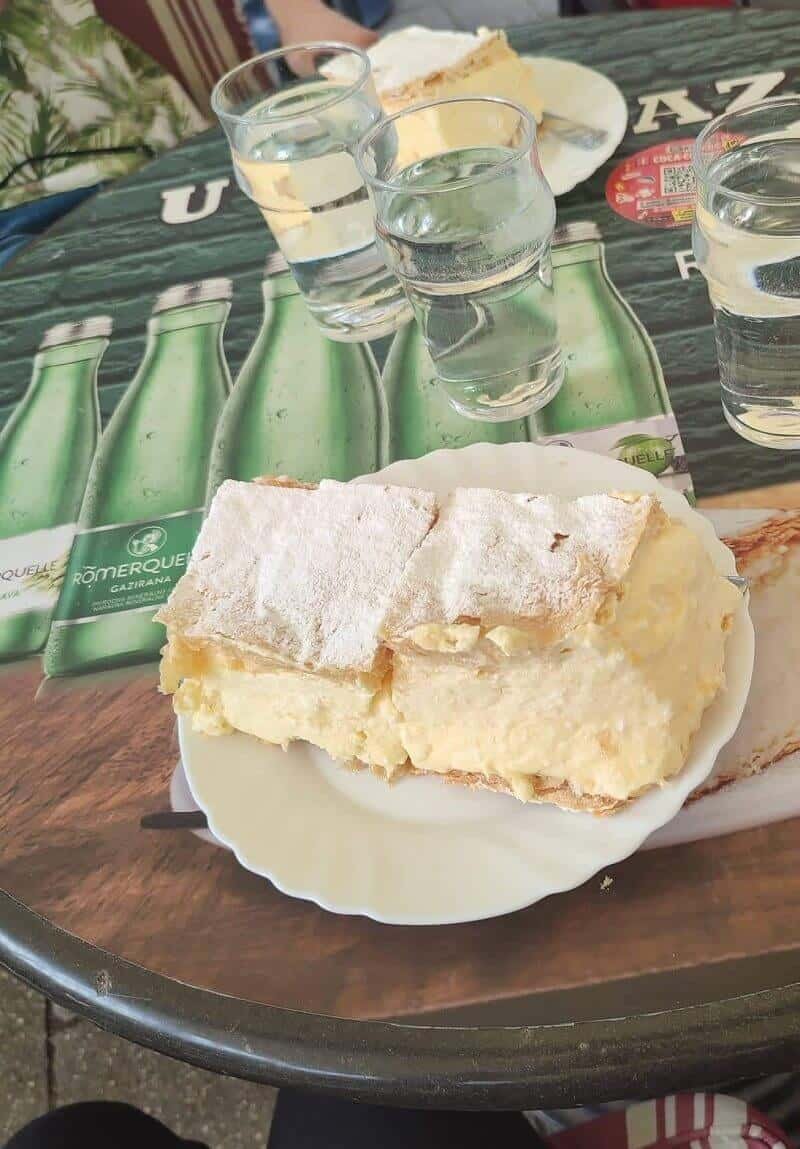
Kremšnita is a traditional Croatian pastry dessert that originated in the town of Samobor.
Whenever I travel to Zagreb I stop on the way to Samobor to enjoy Kremšnita and mead.
Kremšnita is made from two layers of puff pastry filled with vanilla cream custard and whipped cream.
There are variations to the original recipe, but what recipes have in common is the baked layers of pastry which become golden and then powdered with sugar while inside is the thick layer of vanilla cream custard and whipped cream that makes you want to eat more and more.
While you’ll find many variations of Kremšnita, I recommend the original Samobor Kremšnita because it’s simply outstanding.
Samobor Kremšnita is soft, puffy, and refreshing while some other variations tend to contain gelatine and trade the puffiness for more thick texture and dominant vanilla custard flavor.
Štrukli (cheese and pastry dish)
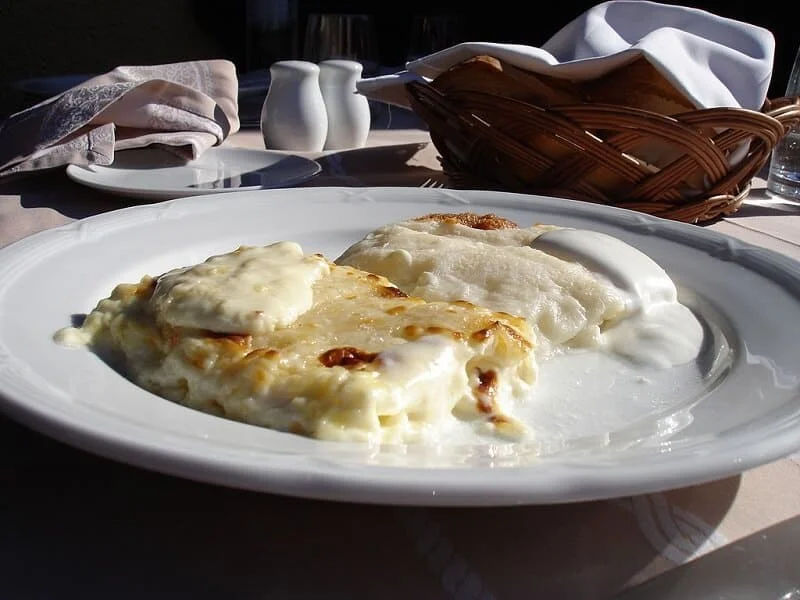
Štrukli is made from sweet dough filled with cheese baked in the oven and must be a real delicacy for all of you with a sweet tooth.
The caramelized dough topping and inside of creamy, soft cheese followed by the glass of milk require no further explanation.
You’ll find great Štrukli in Zagorje, especially if you have the privilege to eat in someone’s grandma’s kitchen.
Croatia has a variety of great sweet traditional food, but if I were to mention everything in one article, You’d never leave this website.
Similarities with Italian cuisine
Croatian cuisine by the coast has similarities with Italian cuisine. For instance, you’ll notice that olive oil is used as the primary choice for many dishes, Parmigiano Reggiano is among the most popular cheeses, Italian pasta recipes are a common launch in households, and herbs such as basil, oregano, rosemary, sage, and thyme are grown and used in Croatian cuisine just as these spices are a norm for Italian cuisine.
As you can see, the Mediterranean influence is strong in both cuisines and has been in the culture for centuries which shouldn’t surprise.
You can enjoy one style of food similar to Italian cuisine by the coast and then by traveling only for a few miles towards the continent, you’ll find completely the opposite cuisine that has nothing in common with what you tried before.
Similarities with Turkish cuisine
Although more prevalent in continental Croatia, there’s some influence from Turkish cuisine in Croatia.
We are talking about literal recipes that originate from Turkey that aren’t a normal part of a tradition in Croatian cuisine but got accepted over time.
I didn’t mention these dishes in the list above because they are not considered indigenous Croatian dishes, but you can find those dishes in many places whether it’s a restaurant or fast food!
All of these recipes came to Croatia from Bosnia, as Bosnia was under the Ottoman empire for centuries, so lots of modern Turkish cuisine, traditions, and even language can still be found in the region of Balkan.
Although the Ottoman empire never conquered Croatia, its influence was nevertheless strong.
Thus, you’ll find phenomenal dishes such as popular meat pies called “burek”, and other pie variants stuffed with vegetables, butter, and honey. “Cevapi” and “Sarma” probably also pull the strings from Turkish cuisine but over time, the dishes would get accepted and then the domestic cuisine would get inspired and create similar dishes from one influence.
Some people would argue that none of the mentioned food such as Cevapi, Sarma, and Burek should be called Croatian food due to their roots that come from Bosnia, however, getting into such arguments could easily become overwhelming as in Bosnia live Bosnian Muslims and Croatian and Serbian Christians.
Thus, so many cultures and traditions got entangled and created a lively and rich cuisine!
It’s not unusual for people from Croatia to have grandmas and cousins all across the state or in nearby states such as Bosnia, Slovenia, or Serbia, so the recipes and cooking methods are shared across the state.
Dino is a local who has spent 27 years of his life in Croatia. He's here to provide you with useful information and some local guidance.
Recent Posts
The Best Cities in Croatia For Walking
Croatia is small and best enjoyed on your foot, as usually, you will find everything important within the city's main zone.From the bustling streets of Zagreb to the picturesque coastal paths of...
How Many Days to Spend in Croatia?
Croatia has so much to offer and I am often asked how many days a tourist should dedicate to exploring and enjoying the best of Croatia.So, how many days to spend in Croatia?7-10 days is...
- Cast & crew
- Episode aired Jan 16, 2008

Dennis Valcich runs through the key ingredients used in Croatian cooking and demonstrates a recipe from the Dalmatian coast - artichoke with potatoes and broad beans. Dennis Valcich runs through the key ingredients used in Croatian cooking and demonstrates a recipe from the Dalmatian coast - artichoke with potatoes and broad beans. Dennis Valcich runs through the key ingredients used in Croatian cooking and demonstrates a recipe from the Dalmatian coast - artichoke with potatoes and broad beans.
- Maeve O'Meara
- Dennis Valcich
- Mira Valcich

- Self - Host
- (as Slavko 'Jim' Bosnjak)
- All cast & crew
- Production, box office & more at IMDbPro
User reviews
- January 16, 2008 (Australia)
- Kismet Productions
- See more company credits at IMDbPro
Technical specs
- Runtime 25 minutes
Related news
Contribute to this page.
- IMDb Answers: Help fill gaps in our data
- Learn more about contributing
More to explore

Recently viewed

- Get in touch
- Store Locator
Croatian recipes for all seasons and tastes
Learn to cook authentic Croatian dishes that made your ancestors healthy, strong and happy.
Croatian food is simple but hearty; easy but full of flavor. To enjoy its tastes to the fullest, you must understand the wisdom and the culture of eating in Croatia. I’ll show you how.
Why you should eat and cook like a Croat
If you have Croatian roots, you already know that Croatian cooking is healthy and homely. These three features make our dishes so very tasty and nourishing.
Croatian recipes have no shortcuts. Food is prepared at home, from scratch. The flavour comes from quality ingredients but also from slow culinary techniques.
Our traditional dishes always use seasonal ingredients. But Croatian eating culture also teaches you when to eat fresh, when to ferment, preserve, dry or cure.
Sustainable
Croatian time-tested recipes reveal the wisdom of balanced, mindful eating. We can learn to respect and sustain our planet from how our ancestors cooked and ate.
croatian eating cultures
Enjoying Croatian dishes is much more than recreating Croatian recipes. You must first understand how we eat: our rituals, the meaning of our favourite foods, our cooking techniques. And most of all, how we behave around food.
Grah Recipe – Yummy Croatian Bean Soup For Every Day And Special Feasts
Authentic ajvar recipe: how to make the famous croatian spread, croatian snacks: 13 delicious savoury pastries that will make you drool, easter in croatia: 7 traditional recipes that we adore on our table, 7 yummy spreads croats love to put on their bread, how to cure a hangover in croatia: best home remedies, croatian desserts: 13 sweets the world should know about, 10 yummy secrets every foodie must know about croatia, how to enjoy a croatian bbq even if you‘re a vegetarian, croatian sausage tells it all about the country and the people, sweet croatian recipes.
Croatian sweets are our ultimate comfort food. They are hearty, but not too sweet. The best ones are those made and served at home. So if you have a sweet tooth, you will want to check my easy-to-follow recipes and get baking.
Croatian palacinke: how to make perfectly thin European-style crepes
How to make famous croatian bajadera chocolate at home [recipe], krostule recipe: croatian crispy and sweet angel wings cookies, authentic fritule: original recipe for sweet croatian fritters, cupavci – croatian lamingtons – a sweet that takes you back to childhood [recipe], how to make bobići: croatian almond cookies dedicated to the dead, let’s make croatian oblatne – finger-licking good chocolate wafer cake, forget dutch baby pancakes – stuff your face with the puffy croatian supita, croatian sweet pinca bread: 5 secrets and a secret recipe.
get my best-selling, english-language
Croatian cookbooks
Sold over 10,000 copies already, Croatian Desserts features 50 authentic, easy-to-follow dessert recipes. The glossy cookbook boasts more than 500 color images with step-by-step baking method.
With 100 savory recipes and 700 images, Croatian Classics is the only cookbook you'll ever need to master the delights of Croatian cuisine. All the ingredients are expressed both in metric and imperial measures - no more conversions.
Croatian Savoury Baking cookbook will delight all lovers of burek, bread and hearty savoury pies. It boasts 50 recipes and over 700 colour images, turning you into a pro baker in your kitchen.
savory croatian recipes
Croatians know how to mix and match healthy, one-pot meals, simple grilled delights with seriously delicious carbs. The trick is balance, and always making sure you feed both your body and soul.
Croatian Punjene Paprike – Easy And Authentic Recipe For Stuffed Peppers
How to make a traditional croatian gulas: quick and easy recipe, authentic soparnik: the easiest way to bake croatian kale pie in the oven, cheese puffs recipe: a must-have snack at your house party, perfect rezanci recipe: how to make croatian hand-cut soup noodles, croatian blitva recipe: how to cook the ultimate leafy green magic bullet, how to make the finest croatian pogacha bread in your home kitchen, easy baked sardines: recipe for the ultimate mediterranean diet meal, croatian peka recipe: how to make the most delicious veal or lamb roast, how to make simple tomato soup with fresh tomatoes croatian style, croatian potato salad recipe: 5 tricks to super charge your favourite bowl, how to make mlinci: croatian pasta to enjoy with roast turkey, croatian drinks.
Two most famous drinks you are likely to enjoy in Croatia are coffee and rakija (brandy). We enjoy them in various ways and combinations. And we are also a wine ccountry - wink, wink.
Turkish coffee recipe: the brew that we love making in every Croatian home
Bevanda and gemist: 7 ways to make watered wine in croatia, how to make rakija in 10 steps according to croatian locals, how to make croatian red and white mulled wine to warm up the holidays, croatian christmas food.
Holiday food is extremely important in Croatia. We make our festive menus extravagant and abundant. There are also many interesting culinary traditions during Advent and Christmas, such as fasting and feasting.
How to cook crni rizot: try our delicious black risotto recipe
What is Crni Rizot?Crni rizot is the Croatian version of the Mediterranean
Francuska salata: how to make addictively tasty French salad Croatian style
Francuska salata didn't come from France. And for a Croatian person, French
Croatian Christmas food: 10 yummy dishes you need for a home feast
Croatian Christmas food is simple, hearty and delicious. In fact, it’s no
Mulled wine is a traditional drink which spices up Christmas all over

Why everyone is crazy about Croatian recipes and why you should learn from me
In recent years people have discovered traditional Croatian recipes. They can’t put their finger on why the local food is so tasty. Something is different from the mass-produced dishes, from trendy flavours, even from the posh stuff served by high-end chefs.
Let me tell you the secrets. First off, Croatian recipes are wholesome. They are simple, down-to-earth and commonly passed down from mothers to daughters. This face-to-face transfer of culinary knowledge is why the majority of Croatian households still enjoy home cooked food on a daily basis. Knowing how to cook is a default in Croatia.
Unfortunately, even life in Croatia has sped up. Younger generations often skip the important in-person culinary mentoring. Croatians living abroad are especially craving easy-to-follow recipes.
But because our Mums and Grandmas take being able to cook for granted, their recipes are very short and incomplete. This is the reason why I decided to write my Croatian Desserts cookbook. And the reason why I continue publishing recipes on this blog.
I decode traditional Croatian recipes into manageable steps. I explain why some ingredients are used and in which way. I give you guidance on how to substitute typical Croatian ingredients with the international ones. Most of all, I am precise and to the point, unlike your Gran who followed her intuition, experience and sense of touch.
What you need to know about food seasons and eating rituals
Our small Western world is the world of constant abundance. But this is not how nature works. She is in flux, she changes through seasons and these seasons bring riches as well as restrictions.
The way our parents and grandparents ate reflected the change of seasons. They knew what fruit was in season. When it was available fresh and how it was preserved, dried or fermented.
There is wisdom in embracing nature’s scarcity. In the winter, it is wise to eat more grains and meat. With the dwindling supplies of vitamin C from fresh fruits and vegetables, we cook sauerkraut with a touch of smoked meat. This is a well-balanced meal, as nature intended.
All of my recipes follow these ancient culinary principles. I will always tell you when to prepare and eat certain dishes.
Many eating rituals in Croatia follow the Christian customs of fasting. We eat light food before Christmas and Easter. But other seasonal occasions are also filled with interesting rules and reasonings.
Why is this important? Your health, first of all. But great looks is no small reason either. Ever wondered why Croatians are naturally slim and strong? Believe me, it has to do with seasonal eating and the cycles of fasting and feasting.
How you can save the planet by eating like a Croat
If you decided to eat like a Croatian elder, you’d be helping the planet in a big way. Our grandparent never knew the word sustainable but the way they treated their food produced a negligible carbon footprint.
Our grandparents did eat meat, but they did that rarely and at special occasions. Dishes such as lamb or veal peka style were prepared 2 or 3 times a year. Today, we serve them by thousands and think they are authentically Croatian.
This is both true and false. To appreciate Croatian recipes to the fullest, we need to embrace both what we eat and how we eat.
My recipes will always give you a background story. As a passionate food historian, I’ll teach you which culinary methods are green and planet friendly. We are rediscovering what our ancestors practiced decades ago. Think food foraging, fermenting, drying, curing, smoking...
All these methods are at the heart of many Croatian recipes. I am beyond excited to teach you how to cook them. Stick around and I’ll show you how to eat like a Croat. Eat smart, look great and feel strong.
Join My Croatia Fellowship & Never Miss an Article!
Bond with Croatia over recipes and local stories about food, people and places. Let me start by sending you my foolproof recipe for potica - walnut and poppyseed roll cake.
Get 10% OFF on your first order on all our Croatian cookbooks
Sign up below and get the DISCOUNT CODE
No SPAM - pinky finger
Thank you for joining Croatia Honestly club!
Please check your Inbox. We've sent you the 10% DISCOUNT code.
See you in Croatia Honestly webshop...

76 Amazing Croatian Traditional Dishes That Are A Must Try

12 Shocking Statistics About Fast Food Industry Employee Turnover Rate 2022
Let’s dish about all the Croatian traditional recipes!
Croatia is a small country with a little over 4 million inhabitants. It has only 54,594 square kilometers but its beauty and gastronomy are certainly known in the world.
Throughout its history, Croatian cuisine is intertwined and influenced by a lot of different countries. Its continental cuisine is combined with Austro-Hungarian and Turkish recipes, while its coast is influenced by ancient, Illyrian, and Mediterranean cuisines.
Croatia took history as a basic component and then did everything in its own way. And that’s how Croatian cuisine started. Today, with a mix of this and that, it has some of the most delicious traditional dishes . We are bringing you 76 autochthonous recipes – be brave and try something new!
Cold Appetizers
Blood sausages.
The name isn’t that appealing, right? But don’t knock it till you’ve tried it! Blood sausages or krvavice are mostly made of pork blood and entrails. Krvavice are really unique due to their black coloring and distinctive fragrance. Of course, the recipe and the preparation vary from one Croatian region to the other, but wherever you go, you can’t escape their exquisite taste. It is best to serve them with mashed potatoes and sauerkraut.
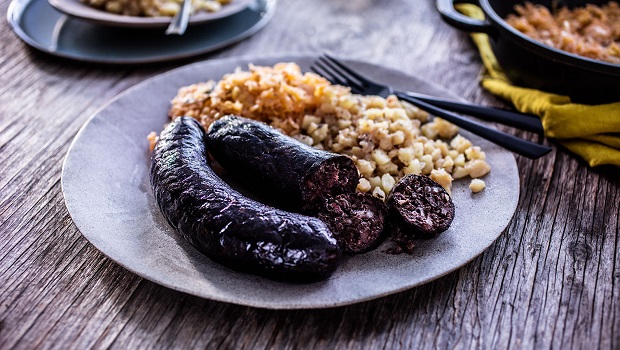
Bread With Olive Oil
Yes, this is a true Croatian delicacy! Olive oil is a symbol of the Mediterranean, especially of Istria where it is cultivated for about 2,500 years so it isn’t surprising that it presents such a delicacy. Oh, did you know that the oldest Istrian olive tree is 1,600 years old? That is an oldie! Istria has 23 varieties of olives and 11 of them are authentic. The recipe for this dish is quite easy – homemade bread with a few drops of olive oil and the enjoyment can begin!

Cheese And Cream
Okay, we know that this may not sound like a specialty, but trust us – it is! This is a traditional dish made of fresh cow cheese with, of course, homemade cream. Before indulging in this delicacy, all you need is a bit of salt and that’s it (you can add red paprika as well)! This meal is especially dear in the region Zagorje (which is also known for really tasty wines).

This is a bit harder to translate but let the taste be our guide. Češnjovke or garlic clove sausages are really popular dish during long winter days. They are made of selected pork meat and seasoning, especially garlic since they got a name after it – češnjak is a Croatian word for garlic. Češnjovke are great raw (dry), cooked, and baked. They combine perfectly with potatoes and greens.
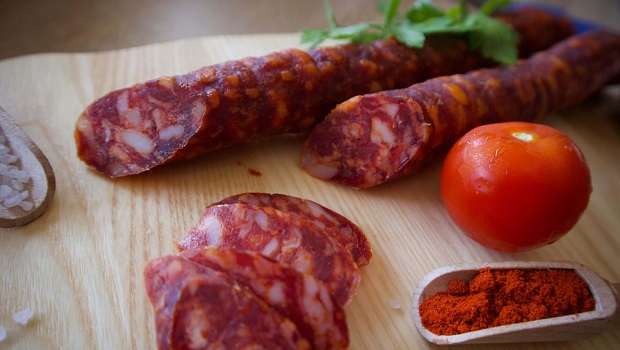
Dalmatian Prosciutto
This gastronomy delicacy is the most prestigious dried meat product of Dalmatia. Yes, we know that almost every Mediteraine country has its own prosciutto but that’s the thing – they are all specific and unique. The Dalmatian prosciutto is made of fresh pork leg in a process called smoke drying. Prosciutto has a quite specific taste which beautifully combines with homemade bread and red wine (try “Plavac mali”, it is one of the most famous wines of that region – if you buy some wine to take it home with you, make sure to use the vacuum sealer to seal it completely.

Istrian Ham
Istrian ham or prosciutto is highly known in the gastronomy world. It is made of pork and intertwined with a unique blend of seasoning and spices so the ham has a distinctive and really unique fragrance and taste. Istrian ham is usually dried for about one year and then served with homemade bread, olive oil, and Istrian Malvasia.
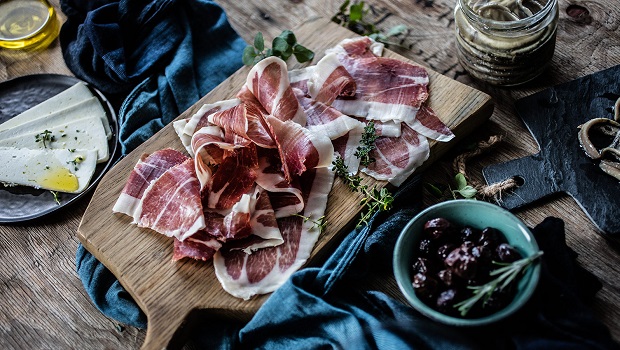
Istrian Ombolo
The ombolo or žlomprt, is a part of a pork chop. The meat is chopped and rubbed with salt, paper, and bay leaf, then it is dried for about 3 weeks. The dish is really simple but oh, so tasty! The ombolo is served with a few drops of olive oil, eggs, and bread. White wine such as Malvasia adds a bit of spice too.
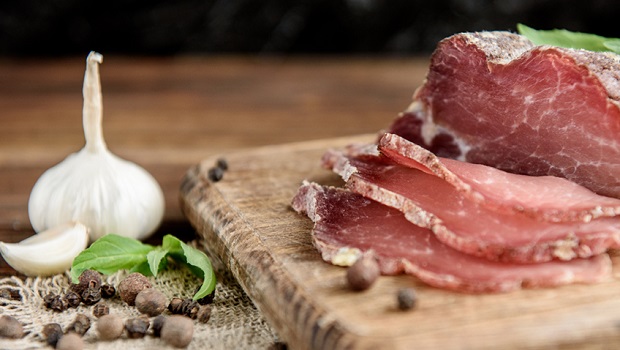
Istrian “Soup”
We got a treat for you! This is, as they said, not your usual soup but beauty for your soul, comfort during the cold days, and delight in the summer. First things first – the Istrian soup is not actually a soup. The bowl called “bukaleta” contains a wine in which you dip a piece of homemade bread. You can grill the bread if you like the crunchy texture. We surprised you, didn’t we? This is an old Istrian traditional dish that is usually served as a meal or after the meal but since we’re true gastronomists, we’d served this as an excellent introduction into the gastronomy adventure that follows.
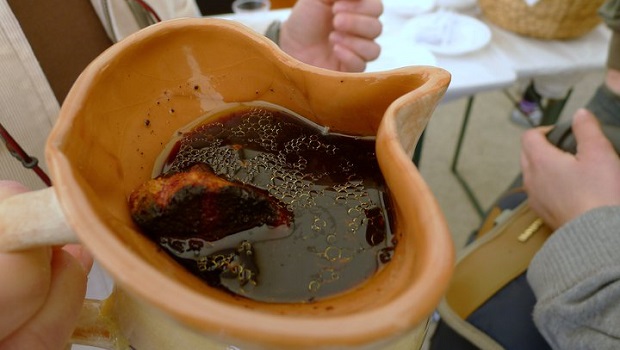
Let’s go further south with our recipes. Fresh oysters are known since the renaissance fests of the nobility of the town Dubrovnik. The most famous story about the oysters is that they are aphrodisiac with magical nuances. Well, that may be just a story (or maybe not, who are we to judge!), but the true magic of the oysters is their taste. They need to be served cold and fresh, only then you’ll meet their true natural flavor and juice. Of course, let’s not forget garlic, lemon, and a few drops of olive oil …
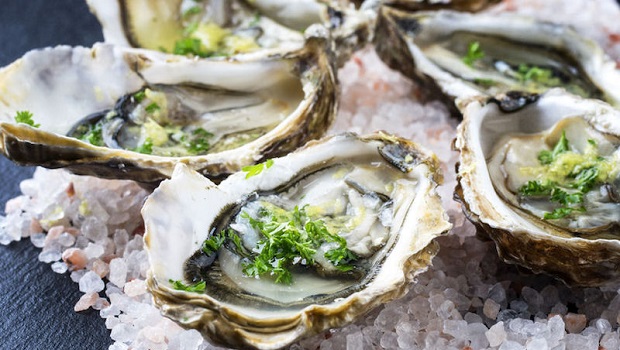

Octopus Salad
Since we’re already in the area, let’s talk about octopus salad. This is a perfect cold appetizer that you need to try when you’re in Dalmatia. The fresh octopus is cooked and prepared with potatoes, garlic, parsley, olive oil, and salt. It is served cold with a few pieces of lemon for that sour touch. Of course, depending on the recipe, the salad can go with tomatoes, olives, and other ingredients.
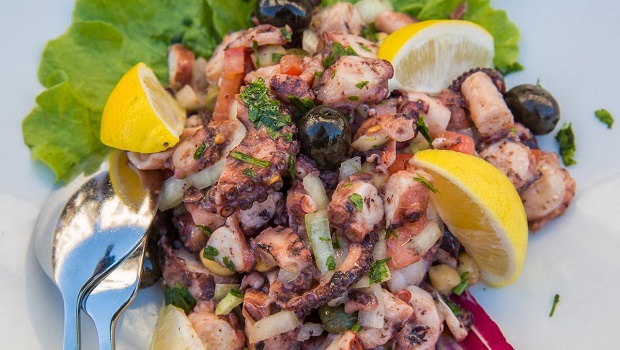
This autochthonous Croatia delicacy combines a homemade dough with chard, onion, olive oil, and garlic. Soparnik is a traditional dish great as a cold appetizer. It is also the first recipe that is listed as the protected cultural asset of Croatia. Soparnik is delicious and it is a great opening act for the main course (or as a daily snack).
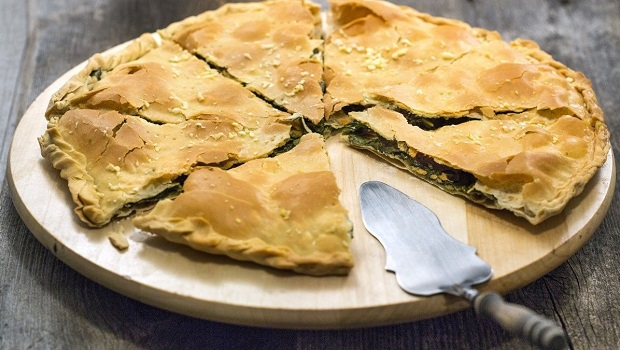
Island Pag is known for its lace and cheese. The Pag cheese is a protected cultural heritage. It is made of goat milk and it is declared the best goat cheese in the world on the Global Cheese Awards in 2017. Do we need to say more? The Pag cheese has a nice spicy flavor and it just melts on your palate. It is served with a nice wine.
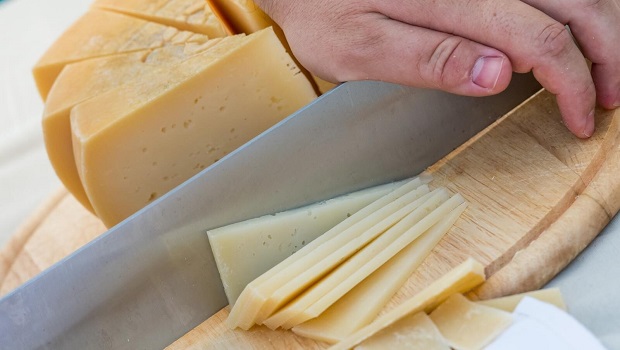
Čvarci or pork rinds are pieces of fried pig skin. They are crispy, salty, and really tasty. Čvarci can be served alone but they mostly go with a sausage (homemade!) and cheese plate. This is a great starter for any main course.
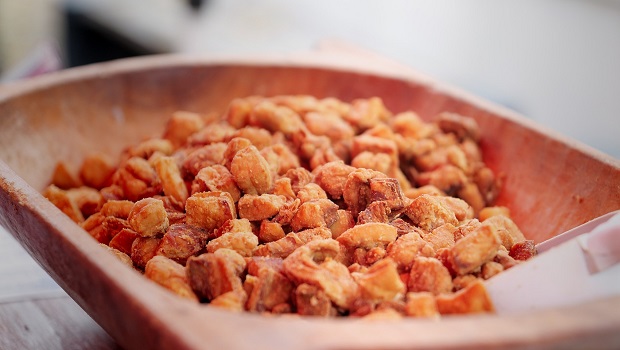
Slavonian Kulen
This is a Croatian autochthon cured meat product. It is made of pork intestine stuffed with a spice mixture and nicely cut pork meat. It has a bit of spicy flavor but it perfectly combines with fresh cheese. Kulen is a traditional product of Slavonija and Baranja and it had a huge impact on their history, tradition, and culture. It is included in the List of the protected cultural heritage of Croatia.
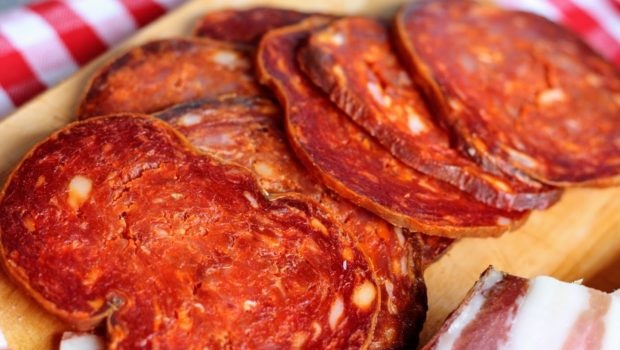
Let’s visit Istria once again since its truffles are known not only in Croatia but in the world too. Istria is enriched with truffles. In 1999, Giancarlo Zigante found in Motovun forest one of the biggest white truffles ever. It weighed 2.88 pounds and it is included in the Guinness Book Of Records. Truffles have a strong fragrance and unique taste, and they are considered an aphrodisiac. There are many ways to prepare them (they can even be in the desserts) and they can be served as both cold and warm appetizers.
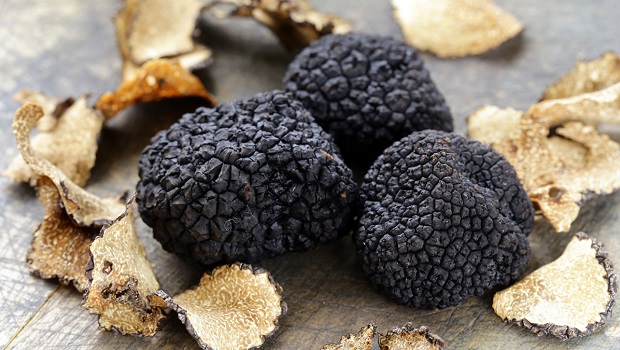
Hot Appetizers
Baked strudels.
This is a true delicacy of region Zagorje! Baked strudels present a Croatian traditional recipe. It is made with homemade dough filled with fresh cheese, sour cream, eggs, and different spices and seasonings. This dish is an excellent hot appetizer (usually served after the soup and before the main course). The strudels can also be filled with sweet apples, jam, cherries, and pumpkins, but more on that when we come to desserts!
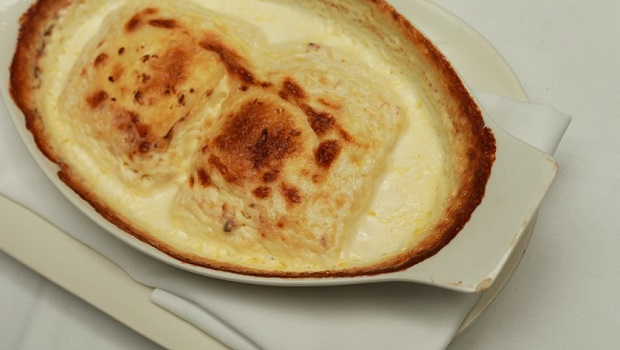
Black Risotto
Ah, this dish is a true enjoyment! This is a sea specialty that is quite traditional in every home of Dalmatia. The black risotto is a creamy dish prepared with rice and cuttlefish which gives the rice that unique black coloring. All the ingredients nicely intertwine and they beautifully offer aromatic flavor, texture, and fragrance. Oh, let’s not forget that a few drops of Prošek (Dalmatian dessert wine) give a special touch to the flavor of risotto!

Blitva (Chard) Na Lešo
Dalmatia is a true inspiration when it comes to traditional recipes and one of them is definitely specially prepared chard. There is no exact word to say what “prepared on lešo” means, so let’s just present the dish so your taste buds can’t wait to try it! In this recipe, the cooked chard is mixed with potatoes, salt, olive oil (is it already obvious that this ingredient is mandatory for most of the recipes?), and garlic. All the ingredients create a nice symbiosis of flavors, texture, and fragrance.
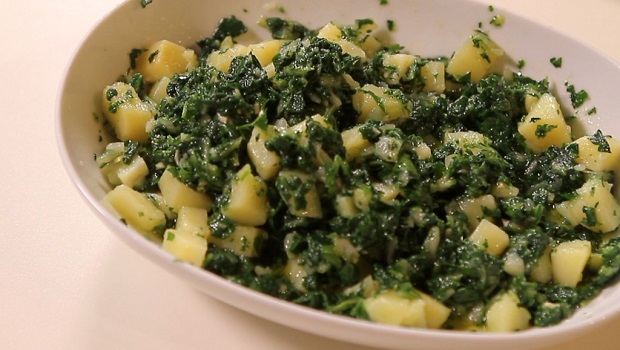
Cooked Strudels
Well, since there are baked strudels, isn’t it obvious that Zagorje also has cooked strudels? Yes, Zagorje loves its strudels! These ones are also made of homemade dough and they are filled with fresh cheese and sour cream. The only difference is that these ones are cooked, not baked! So in the end, you have soft and creamy soup with cheese strudels!
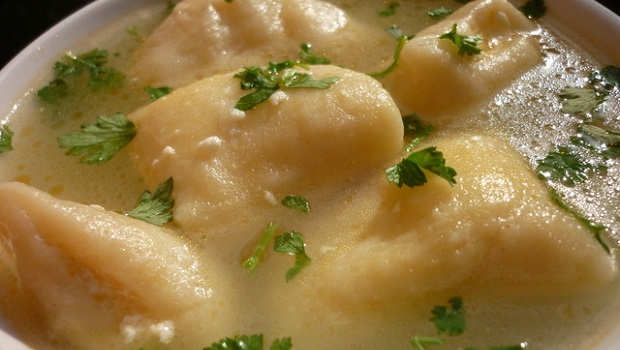
Istrian Fritaja
Hello, Istria again! You probably know that breakfast (or hot appetizer) is the most important meal of the day, right? Well, if you’re traveling through Istria, make sure to try its fritaja! This is a traditional Istrian recipe (even though it got its name after the Italian word “frittata”) prepared of eggs, asparagus, mushrooms, prosciutto, and a few drops of olive oil. Sounds tasty? It truly is!
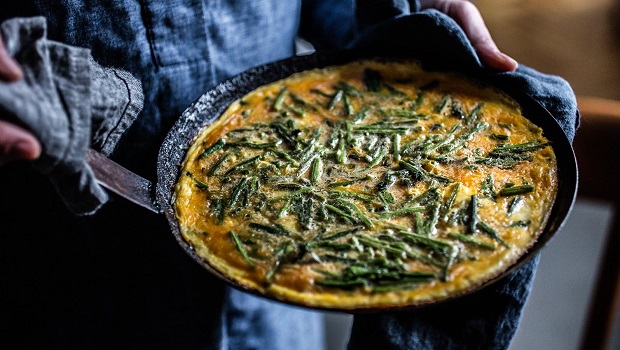
Lika Potatoes
Lika potatoes are Croatian products under the protection of the European Union. Specific conditions of the climate and soil composition contribute to the divine taste of the Lika potatoes, popular known as “pole”. The traditional recipe is quite simple – the potatoes are cut in half and baked in the oven. For a bit more flavor, most cooks place bacon on each piece of the potato. This dish is really hard to resist once you try it, trust us!
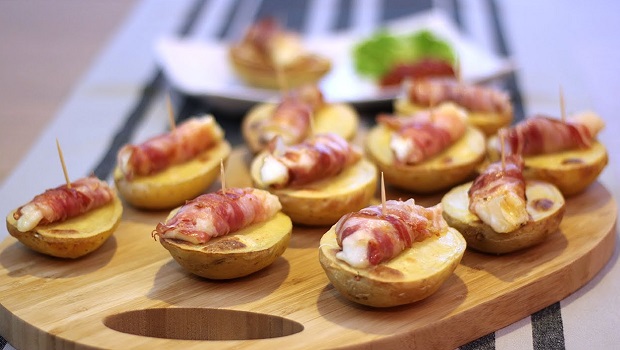
Mussels On Buzara
Fresh seashells present a true delicacy, especially if we’re talking about mussels prepared on “buzara”! Mussels are shells that contain a small amount of meat but due to that, they are a great hot appetizer. It is really popular on the Adriatic coast to prepare mussels on “buzara”. Basically, that means they are cooked in water and white wine with a bit of garlic, olive oil, parsley, and seasoning. All the aromas create a true ecstasy of flavors!
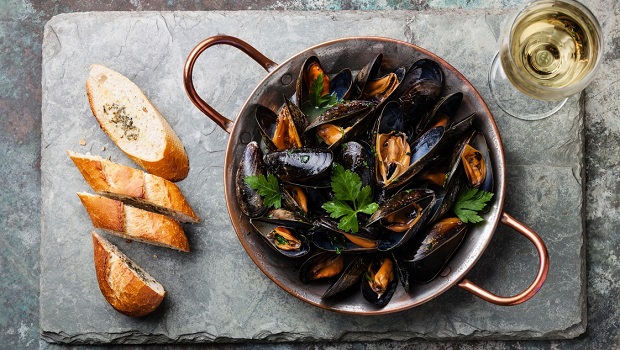
Skradin Risotto
This is probably the most famous Croatian dish and if you haven’t tried it yet – what are you waiting for? It is delicious! The thing that makes this recipe stand out is the time preparation. It takes 20 hours to prepare this meal and 2 days! It combines rice, vegetables, veal shank, veal neck, and chicken. All the ingredients are cooked with seasoning and in the end – they are combined in a perfect texture and aromatic flavor. The risotto is great with parmesan and Skradin wine.
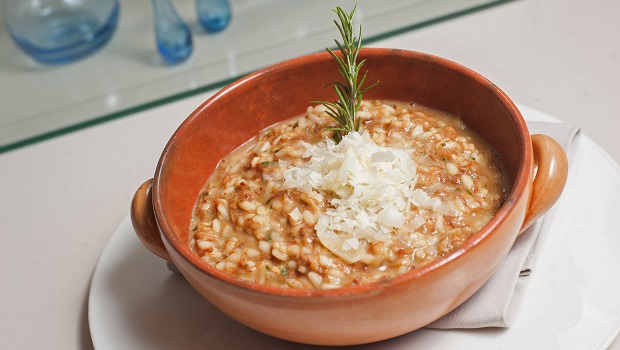
White Risotto
Ah, so many risottos to try and so little time! The white risotto can be prepared with shrimps, squids, and vegetables (some regions prepare it with meat too). The most popular white risotto is the one prepared with shrimps. It is creamy and tasty not only because of a beautiful combination of rice and shrimp, but thanks to the white wine too which gives a nice aromatic touch and flavor.
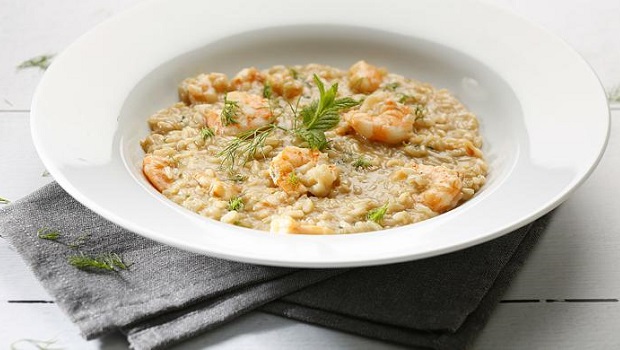
Fuži are traditional homemade pasta that is a must-try-must-have kind of ingredient. This pasta is specific to the region of Istria. In the past, fuži were usually prepared only for festive occasions and they are made of flour and eggs which is quite specific since most pasta is made of flour and water. Fuži look like small flutes and they are great with a mild red sauce. The sauce is prepared with tomatoes, onions, and white wine.
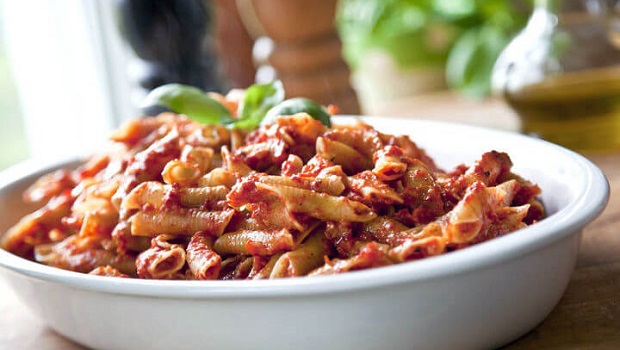
This pasta is popular not only in Dalmatia but all of Croatia. Njoki origin from Italy, but since they are prepared in Dalmatia for so long, every family now has its own recipe so yes, it became a Croatian traditional recipe! Njoki have an oblong body with cute little carvings and their main ingredients are potatoes. They are great with every type of meat so just enjoy them all!
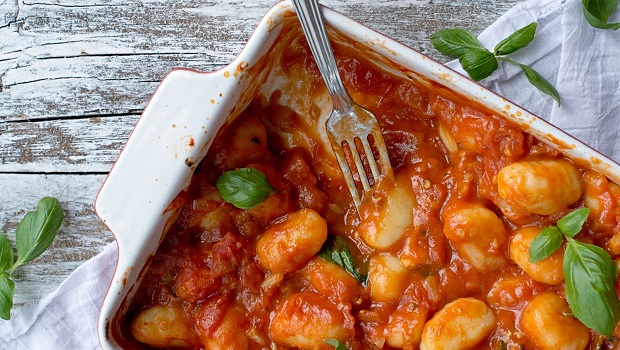
Pljukanci or šurle are quite popular in Istria. This pasta is made of water and flour without oil, salt, and eggs. When they are made, the cooks rub the dough between the palms of their hands so the šurle, in the end, have an oblong body. This pasta is amazing with sauces made of beef or game. Ah, the flavors of pasta are really addictive!

In Istria, this rhombus-shaped pasta is made of flour and eggs. There, they are prepared with salted anchovies with just a bit of breadcrumbs. Then, they are fried in olive oil and served with cod. When all the ingredients are combined together, they create a beautiful mixture of flavors, aromas, and textures. That mix certainly provides a true ecstasy to your palate!
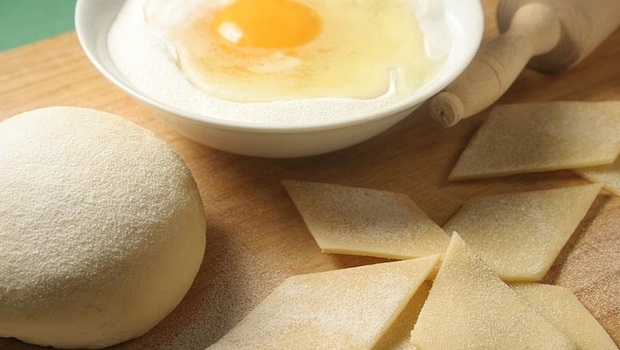
Main Courses
Brač’s vitalac.
The recipe for this dish is listed on the protected cultural assets of Croatia. You know that means two things – it is as old as time and delicious! The dish is made of lamb or goat offal mixed with aromatic seasonings and sea salt. In the end, all the ingredients are perfectly combined and they offer a specific taste of Mediterranean and tradition.
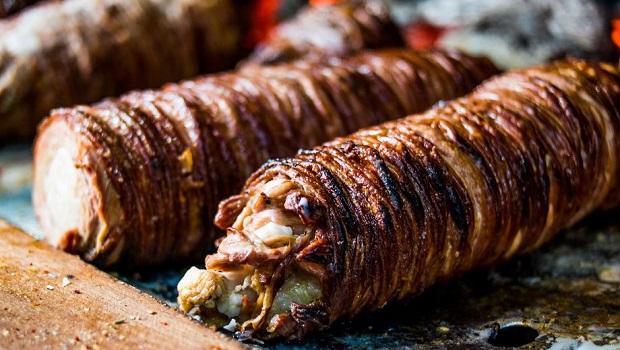
This is a true gastronomy delicacy. Boškarin is a cattle that mostly resides in Istria and it represents a symbol of that region so yes – it is prepared in an original and traditional Istrian recipe. Boškarin has a quite specific taste and its beautiful aromas are mostly served with pasta such as fuži and njoki and/or a variety of vegetables. Boškarin is such quality meat that it is served only in top restaurants!
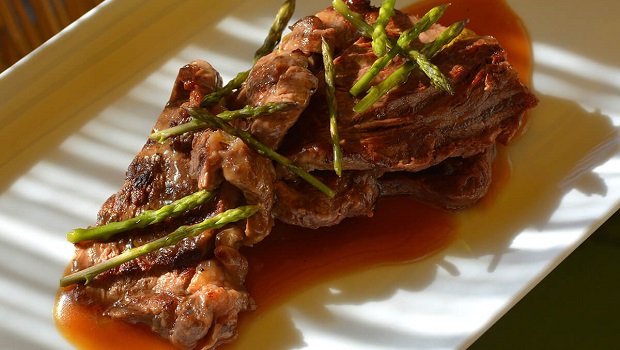
Buzara With Shrimps
Buzara with shrimps is an autochthonous recipe from Dalmatia. The flavors of shrimps are beautifully intertwined with the seasoning such as parsley, garlic, pepper, and of course, olive oil. You’ll get a bit dirty while eating, but trust us, it is worth it! Oh, and don’t forget to dip homemade bread into the cooking sauce – your taste buds will be seduced right away!
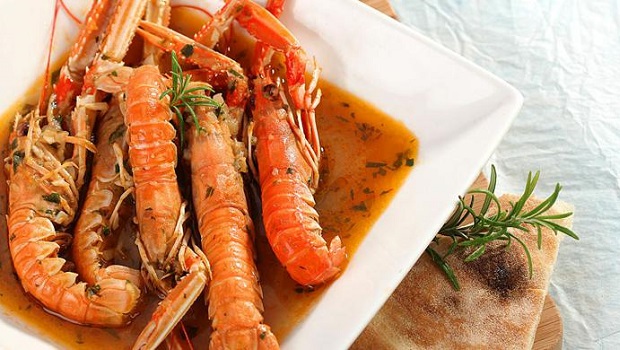
To say it simply – this is a fish soup/stew. To say it in a gastronomic way – this is a dish that will seduce you right that instant with its flavor and fragrance. It is mostly prepared with grouper, shrimps, mussels, and all kinds of fish and shells, depending on the recipe because yes – it varies from home to home, from one restaurant to another. But what we can tell you with certainty is that you’ll love brodetto!
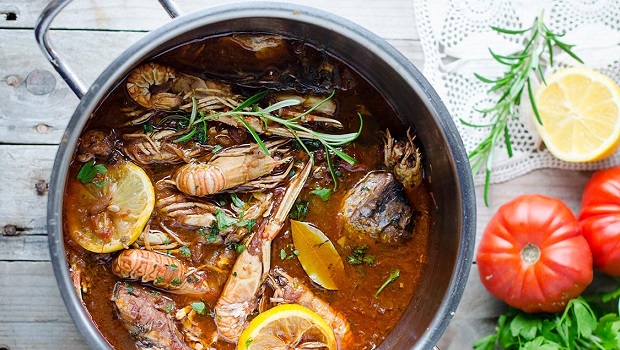
Buncek with sauerkraut is a dish that is present in Croatia for centuries. It is mostly prepared in autumn and winter days and it truly is a tasty delicacy! Buncek is pork’s lower leg and it is firstly smoked and then cooked. The best way to try it is with sauerkraut. Their flavors work beautifully together and they will certainly be a highlight of your vacation!
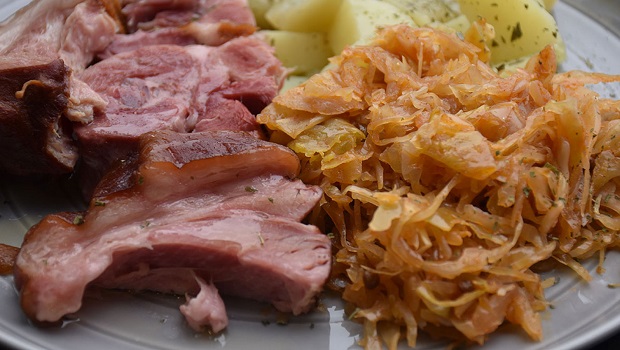
Carp In Forks
This dish is a classic in Baranja. The carp is cut along its belly and then placed on the forks above the fire or heated coal. This is a traditional carp preparation on Christmas Eve. The meat of the carp is juicy, while its skin is crispy. When the carp is done, it is served with potatoes and vegetables. Trust us, once you try this recipe, there isn’t going back, it will be your number one fish dish!
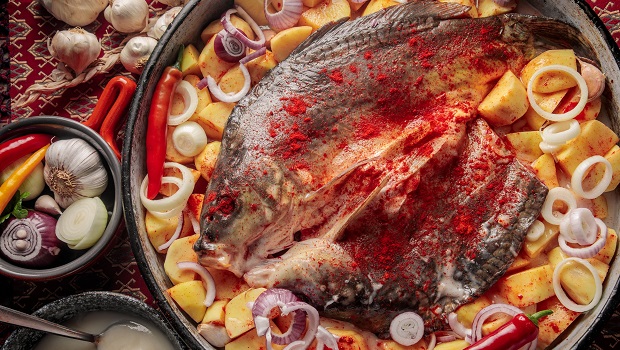
Fish is surely one of the favorite gastronomy ingredients in Croatia. One of the traditional fish recipes is a cord “na bijelo” or with potatoes. This delicacy is usually made on Christmas Eve. The cord has an intense fragrance and juicy meat. If it is prepared “na bijelo” then it presents a perfect creamy pasta great for dipping crispy bread in it. If it is prepared with potatoes, then it provides a true ecstasy in the combination of potato, garlic, parsley, olive oil, and lemon!
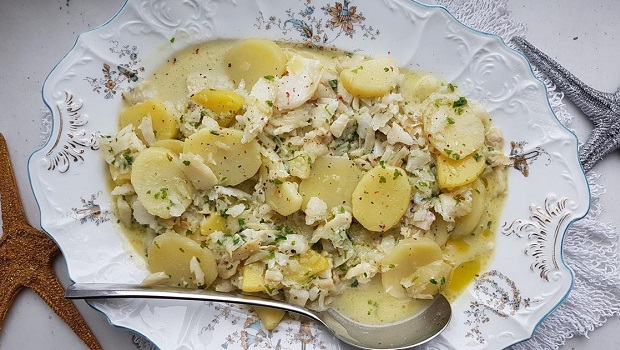
If you really want to try traditional recipes of Croatia, make sure that čobanac gets on your list! This is a stew delicacy of continental Croatia and it has a basic recipe that is then formed according to the region. But every čobanac has a lot of onions, cube-cut meat, tomatoes, pepperoni, pepper, wine, and more. Now, imagine all that ingredients synchronized in a unique flavor that seduces your taste buds – a beautiful gastronomic experience, right?
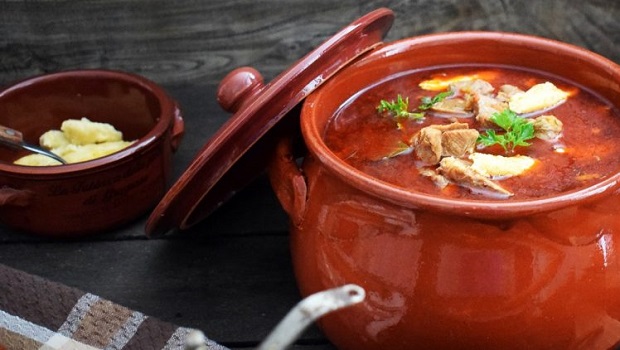
Dalmatian Pašticada
We must warn you – this is a Dalmatian pride and glory so be ready to indulge in unique flavors and aromas. Pašticada originated from Italy, but Dalmatia took its basic recipe and make it unique and special. Pašticada is made of beef fricando filled with bacon and marinated in wine, vinegar, water, salt, paper, and bay leaf. After that, it bakes with vegetables and in the end – it just seduces you with its flavors.
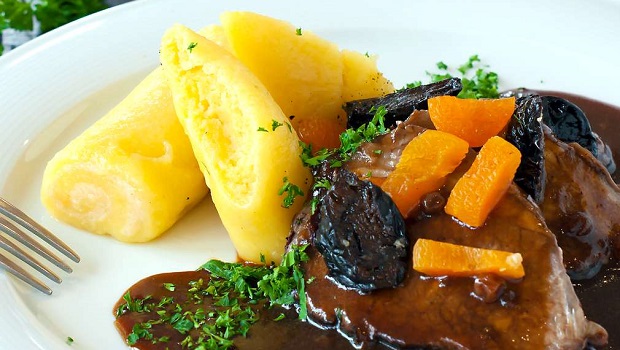
Dubrovnik Šporki Makaruli
This is a typical specialty of town Dubrovnik . Šporki makaruli is a dish made of beef or veal with sauce and pasta in the shape of macaroni. The dish got its name because of its specific servings. The meat is placed over the pasta so once you eat it, you’re just left with – šporki makaruli (only pasta). In the past, lords of Dubrovnik prepared this delicacy for Saint Vlaho, a patron of the city.
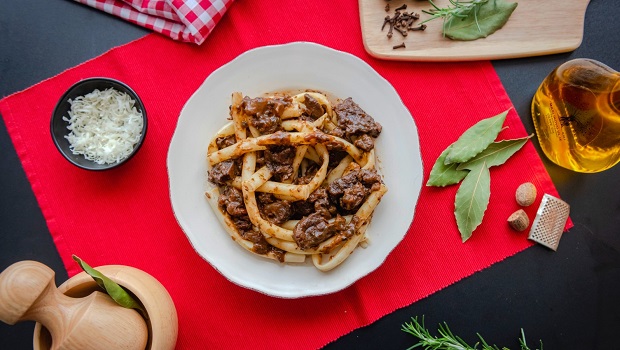
Edible Dormouse
Okay, we know, this is a weird one, but trust us, it is a delicacy on the Croatian island Brač. Gourmet dormice are incredibly tasty. They have a lot of fat and due to that, a specific flavor so they are often described as pork with sweet nuances. They are baked on the stick on fire and once they’re done, (and headless) they are put between two bread, and there you have it – a dormouse sandwich!
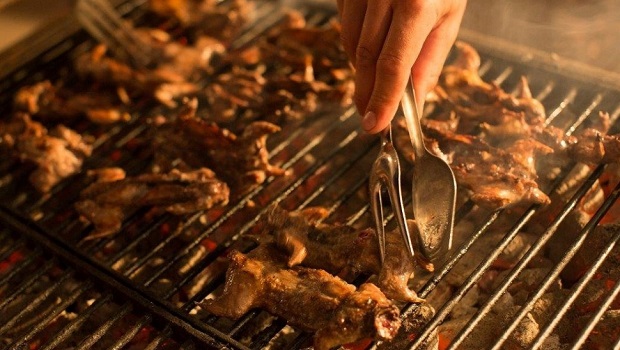
Grilled Fish
This is a classic Dalmatian dish that is prepared in every home and restaurant all along the Adriatic coast. Almost every fish is suitable for the grill so you can taste sardines, mackerel, saithe, tuna, sea bream, groupers, and more. The fish is perfectly baked so its crispy skin beautifully blends with juicy meat. Grilled fish is great to taste in combination with chard, potatoes, and vegetables so in case you’re sailing in Croatia, island hopping, or just enjoying the coast, make sure to try this delicious dish (oh, and it can be prepared indoors too with these amazing indoor electric grills !).
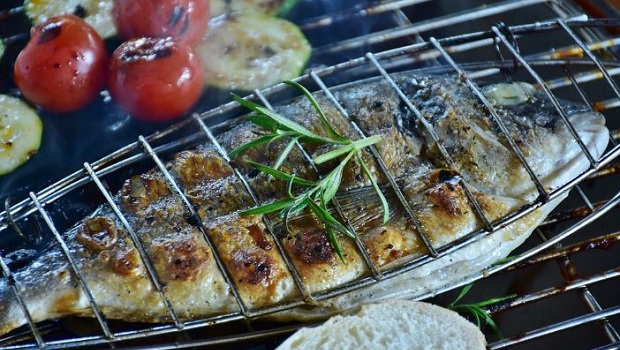
Ham In Bread
Ah, this is a dish that is really hard to resist. It is usually prepared for Easter in continental Croatia. To put it simply, it is homemade bread stuffed with a piece of ham. During the baking, the bread absorbs the flavor, juice, and aromas of the ham, which certainly contribute to its final flavors. Your taste buds will love this one!
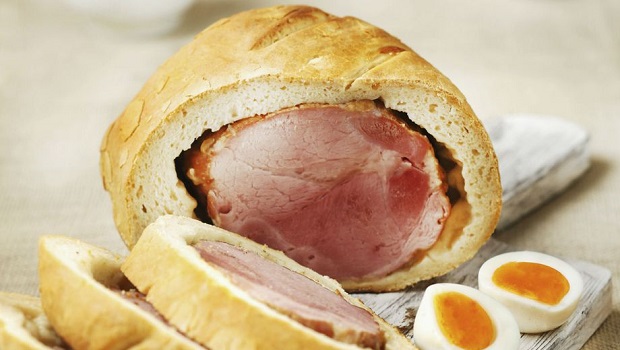
Istrian Fuži With Truffles
We already mentioned both of these ingredients but we didn’t mention them together! We’re not sure which of the ingredient is better so why not combine and mix them into a traditional Istrian recipe. The truffles are aromatic and they perfectly blend with the flavor and texture of pasta (fuži). This recipe is a must!
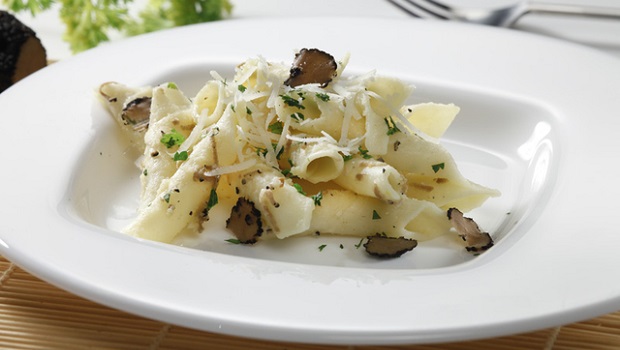
Lamb Under Peka
You haven’t really tried lamb if it’s not prepared under peka! Peka is a specific method of cooking and preparing lamb. It is a bell-shaped iron or ceramic vessel which covers the lamb and potatoes. Then, the cook puts the coal on the vessel until the lamb and potatoes are perfectly prepared. All the ingredients are soft and juicy and they create perfect harmony.

Konavle Green Manestra
This is an autochthonous dish of Konavle, Dubrovnik, and its recipe dated from the 15th century. The Konavle green manestra is a stew made of a variety of meat, cabbage, potatoes, and kale. When serving, the cook grates the horseradish into the plate which perfectly harmonizes with meat and vegetables.
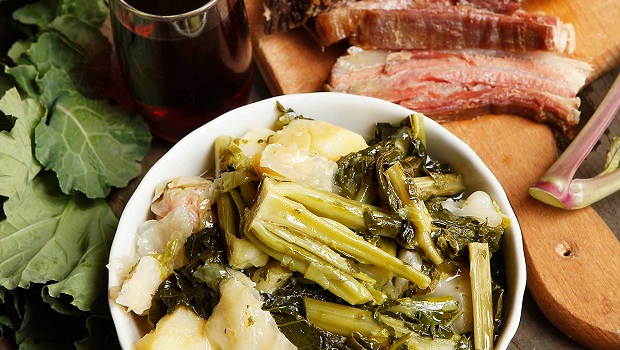
Komiža’s Bread
This dish is a true ecstasy of flavors and tradition. It resembles a bit of pizza but it is richer in aromas, flavors, and ingredients. The Komiža’s bread is made of tomatoes, oregano, anchovies, olives, parsley, and other seasonings. Once the dough is filled with all the ingredients, another dough is placed over it. Baked, all the ingredients are perfectly balanced, harmonized, and juicy. Are you hungry already? We sure are!
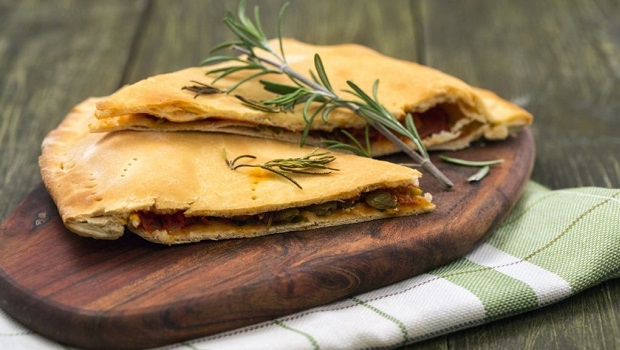
In Croatia, no fair or gathering can go without a kotlovina. The pork chops, chicken, and sausages are the main meat ingredients of this recipe. In Kotlovina, you can also find beans, onions, and other vegetables. All the ingredients beautifully blend their flavors and aromas. Oh, and don’t forget to dip the bread into a cooking sauce!
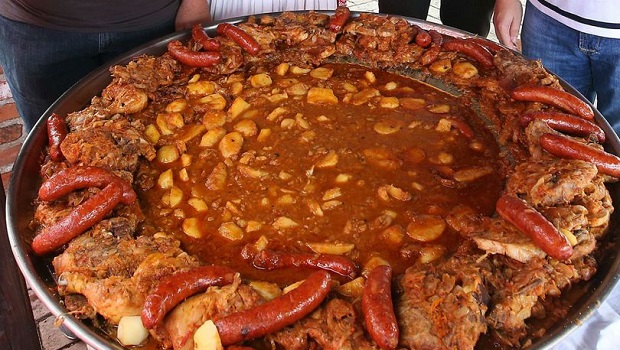
Krpice With Cabbage
If you’re looking for a traditional recipe of Croatian ancestors, this one is probably the oldest one (oh, and so tasty!). This meal was prepared by every grandma. Even though it is a quite simple recipe, it is perfect for every time of the year. The main ingredients are pasta (krpice) and cabbage. They are mixed together in a great main course with excellent flavors.
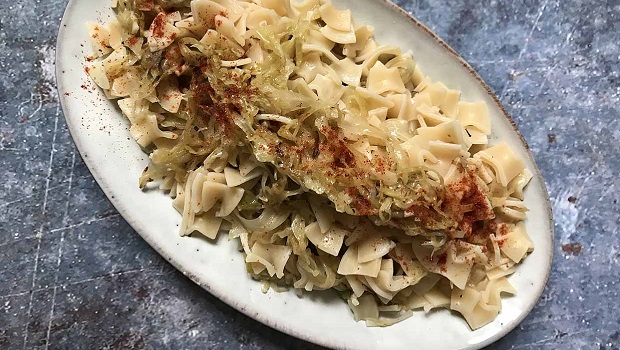
Kvarner Shrimps
We already mentioned buzara with shrimps, but Kvarner shrimps deserve their own paragraph. These shrimps are the most delicious Adriatic seafood. Due to that, they are one of the best delicacies of the Mediterranean. When it comes to their preparation, they can be severed raw, in risotto, with pasta, or, as it is mentioned, on buzaru. Whichever recipe is your choice, you can’t go wrong!
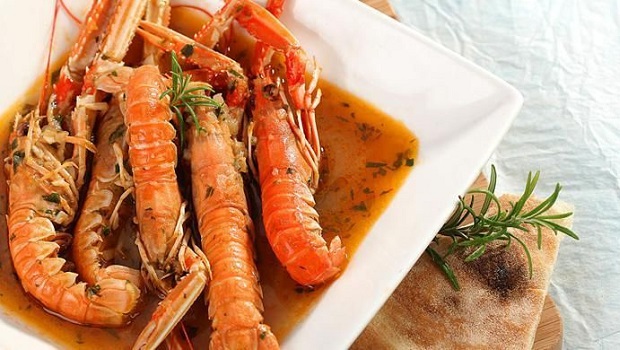
This dish is an Istrian classic and you’ll probably find it in every restaurant there. Manšetra has a long history in traditional Istrian cuisine. The basic ingredients of this dish are potatoes and beans. There are also meat and seasonal vegetables. So basically, maneštra’s recipe is changing throughout the year because it depends on the fresh seasonal ingredients.
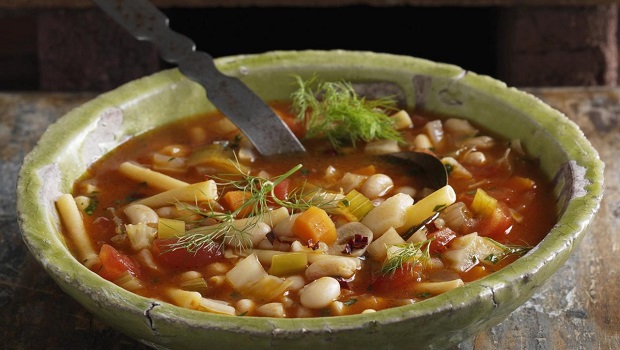
This is a really popular one! The recipe for sarma origin from the Middle East but it is so long in Croatia that we can’t make this list without including it too! This dish is quite simple but it has unbelievable rich flavors and aromas. It is made of minced meat stuffed with rice in sauerkraut and with a bit of seasoning and bacon. Once you try the sarma, you’ll understand why Croats are calling it the queen of winter!
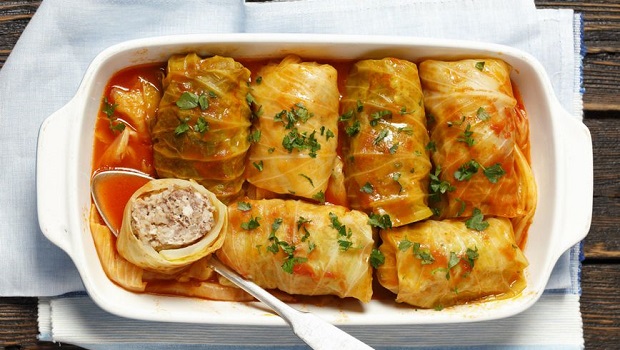
Sinj Arambašići
The dish is actually similar to the sarma but it is made a bit differently – it does not contain rice, while the meat is chopped not ground. This meal is so specific that is on the list of the protected intangible cultural assets of Croatia. Needless to say, the dish is so delicious that it will seduce your taste buds within seconds!
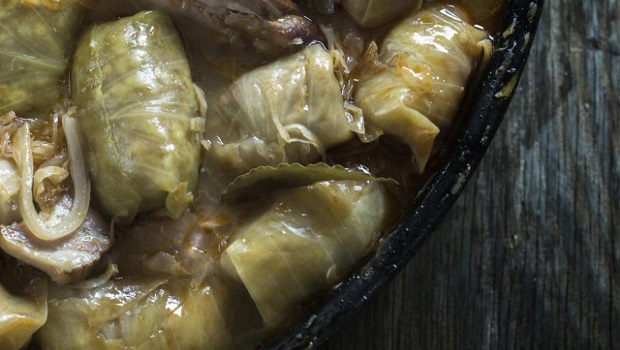
Stuffed Peppers
If you’re looking to try a perfect dish that has peppers as its basic ingredient – this is the one! The recipe is popular in all Eastern Europe but each country has its own traditional recipe. In Croatia, stuffed peppers are mostly prepared in the summer when the peppers are fresh. We probably don’t need to explain what this dish is made of (meat and peppers, surprise!), but this summer, make sure to try it!
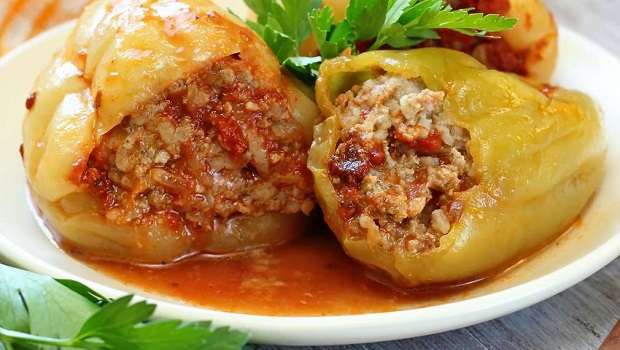
Suckling Pig On A Skewer
In Croatia, “odojak na ražnju” is probably the number one dish! It is prepared for weddings, festivities, gatherings, birthday parties, and more. The entire pig is placed on a skewer and above fire where it rotates and slowly bakes. In the end, the crispy skin perfectly harmonizes with soft and juicy meat rich in flavor.
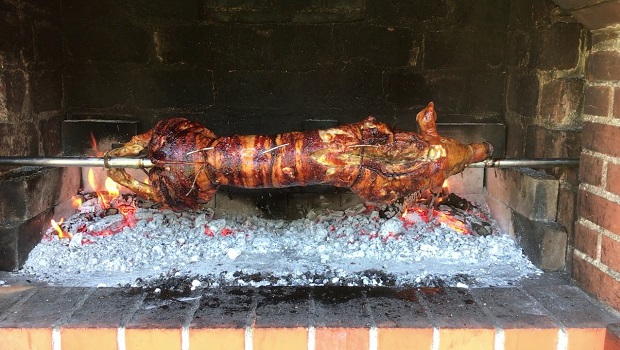
Turkey With Mlinci
This is a classic dish of region Zagorje. The simple but so tasty and rich in flavors, turkey with mlinci is a traditional recipe which is loved by every generation. Pasta mlinci are the 23th Croatia product listed in the register of protected designations of origin. The Zagorje’s turkey is also a protected product. Trust us, once you try the dish, you’ll understand why!
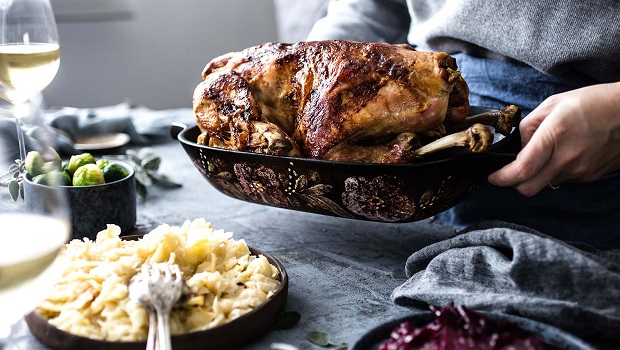
Zagreb Schnitzel
The recipe is a distant and more rich relative of the Wiener schnitzel. The Zagreb schnitzel is made of veal filled with ham and cheese. All the ingredients and their aromas are perfectly balanced and harmonized so they easily seduce your palate and taste buds. This dish is a classic lunch meal in Zagreb, as well as in the rest of Croatia.
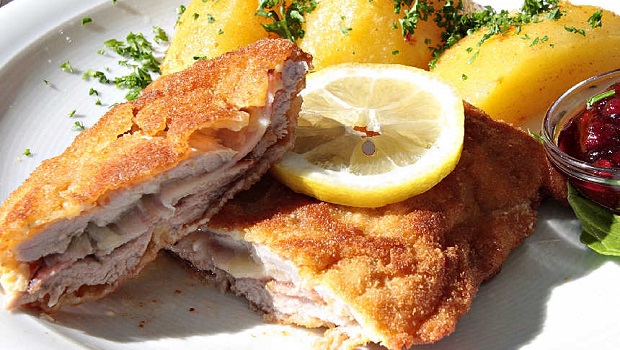
Apple Strudel
So we’ve already mentioned cheese strudels and this recipe is their sweet version. The preparation and ingredients are specific for the region Zagorje. They are simple to make while their flavors and aromas are sweet and juicy. Crispy on the outside, soft and sweet on the inside – what more to ask for!
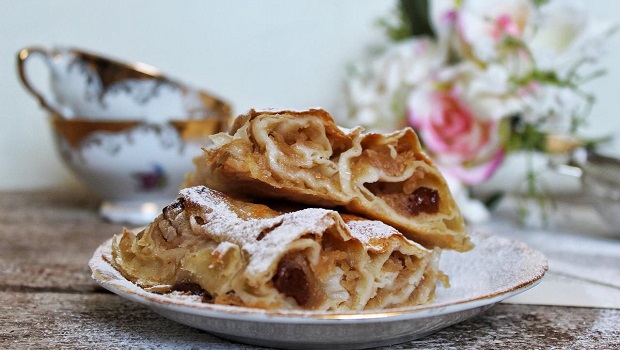
Arancini & Limuncini
Let’s go and visit Dubrovnik. Its recipes for traditional desserts called arancini and limuncini are old and unique. Arancini are made of orange peel, while limuncini are made of lemon peel. Their peel or skin is cut into strips and covered in sugar. They are dried for about a day or two. Once they are dried and done, they are perfectly crispy, while their sour shades beautifully combine with sweet sugar.
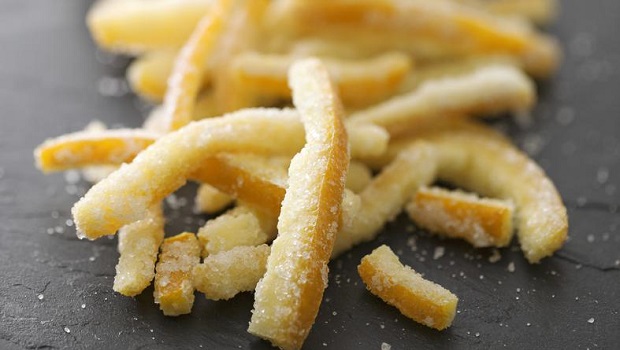
This dessert is a traditional one but it has a lot of variations because every household adds something else, some new ingredients, a bit more of this, and a bit more of that. But in the end, all the variations are hard to resist! To put it simply – bajamini is a sweet bread with almonds. It perfectly goes with coffee, whether it is homemade or from a coffee machine , tea, as well as a snack throughout the day.
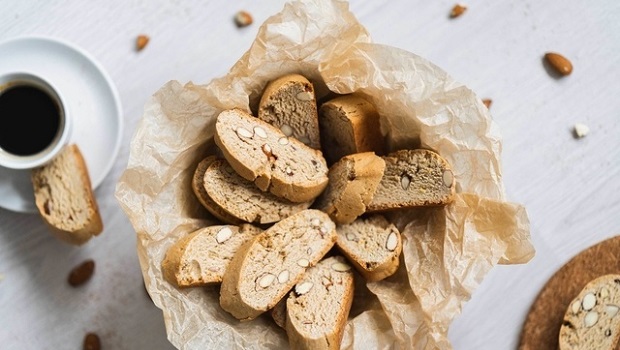
This is a famous strudel recipe of, of course, Zagorje. The homemade dough is filled with pumpkin. The strudel’s outside is perfectly baked and crispy, while its inside is hot, juicy, and tasty. The pumpkin has that specific aroma that beautifully combines with homemade dough. You’ll enjoy this one, trust us!
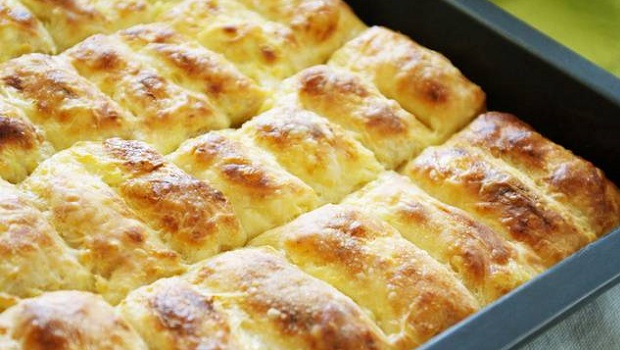
Cake Hrapačuša
Brač truly has some unique recipes and this is one of them! The hrapačuša is a traditional cake of this island. It is simple yet tasty, and it is a protected intangible cultural asset of Croatia. This delicious dessert got its name after a stone it resembles and is made of walnuts so a true pleasure is guaranteed!
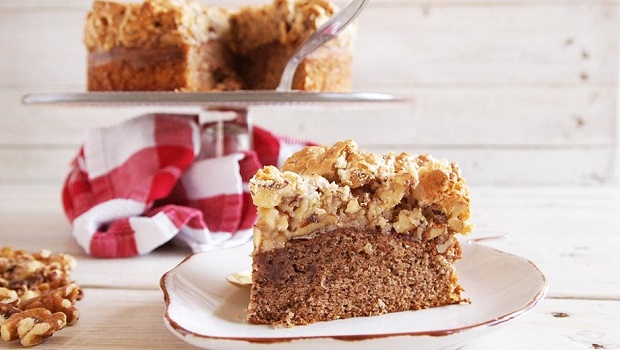
We’ve already mentioned čvarke (pork rinds) as a cold appetizer but did you know that they are used for salty desserts as well? Čvarkuše are small cookies made of homemade dough and filled with pieces of pork rinds. The dessert is great for anyone who doesn’t prefer sweet shades or just loves čvarke!
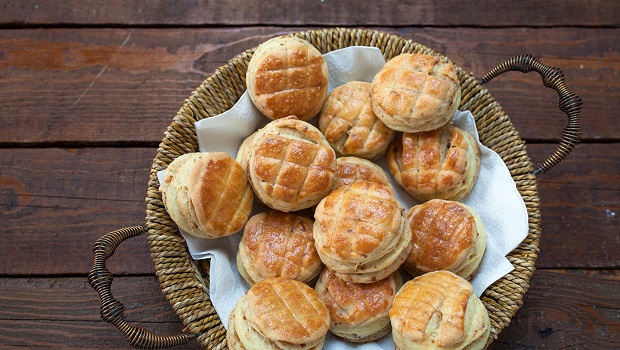
Since we’re already at the Adriatic coast, let’s stay there a bit longer. Fritule are the most popular Dalmatian dessert. They present a delicious traditional cuisine you really shouldn’t miss when you come to visit. Fritule are crispy and sweet and they can be filled with raisins or covered in chocolate. The decision is all yours (but make sure to try all the versions!).
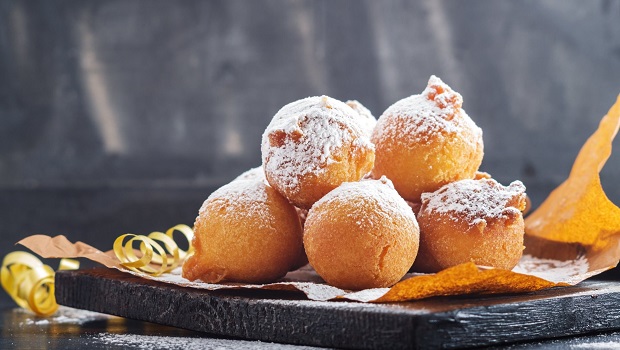
Cake Of Imotski
This dessert is a traditional Croatian recipe of the town Imotski. The cake is often called a queen so let its beautiful shades and sweet nuances seduce you and your taste buds. The basic ingredients of this cake are almonds and a bit of lemon and orange. All the other ingredients vary from one household to the other. But don’t worry – true pleasure is guaranteed!
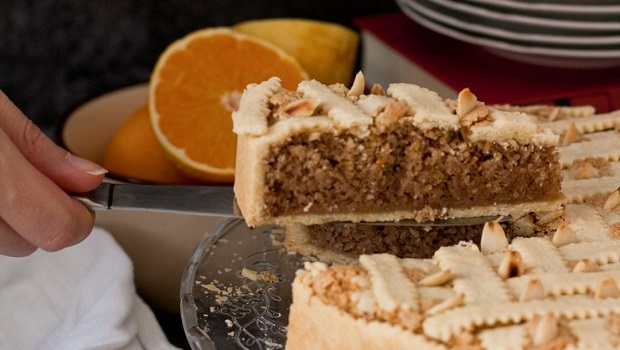
The town of Varaždin has a publicly protected intellectual property – klipiče! The recipe is really old, it originated in the 18th century so it truly presents a traditional dessert of this region. Klipiči are made of homemade dough and they have an oblong body. They can be covered in cumin and once they’re baked, they are crispy and delicious!
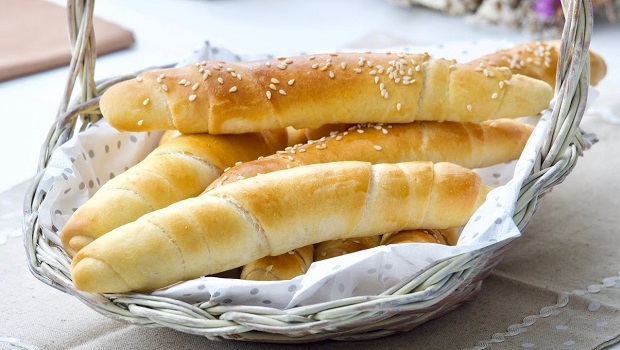
If you want to try something sweet, crispy, tasty, and made in Dalmatia, kroštule are a perfect dessert for you! This is an old and traditional recipe. It is simple and delicious and you’ll truly enjoy that gastronomic experience. Kroštule are made of homemade dough and each of them is tied in a knot. They are covered with sweet sugar and great for, as Dalmatians say, “guštanje” (indulging)!
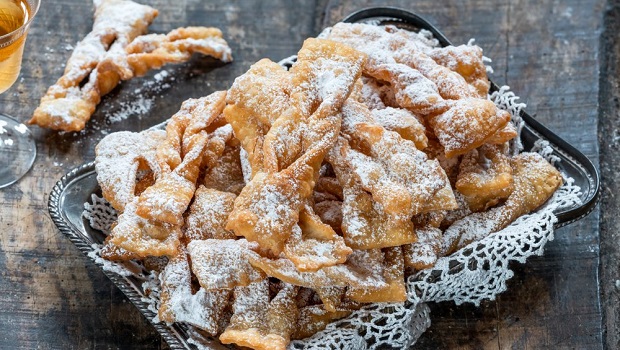
If you love almonds, you’ll really love this recipe! It is a sweet dessert but trusts us – nothing like you’ve tasted before. This recipe use wafers, sugar syrup, and almonds – we know, enough said for the seducing of the taste buds! The mandulat is great for coffee and/or tea time, as well as for snacking.
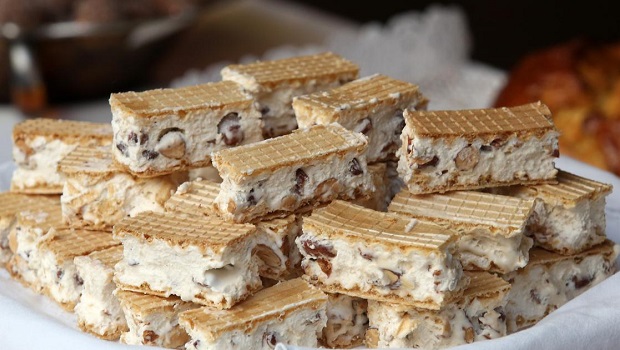
Međimurska Gibanica
Okay, this one you’ll love or hate. Gibanica combines a lot of different ingredients but the way of the preparation and the end result contribute to its beautiful and rich flavors. Međimurska gibanica is made of homemade dough, ground walnuts, poppy, cow cheese, and apples. Yes, we know – a lot is going on there! But this is a traditional dessert which is juicy, and oh, so delicious!
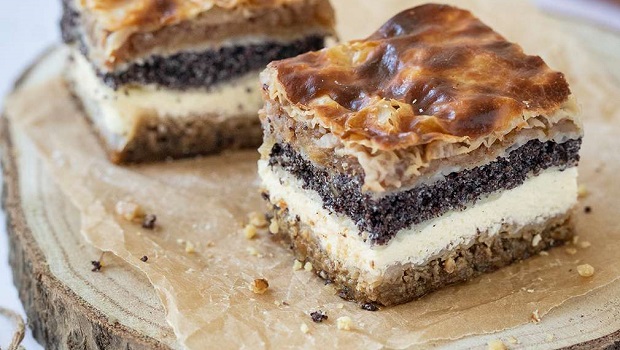
Paprenjak is a traditional Croatian dessert that is mostly made during Christmas time . It has an aromatic flavor with a touch of honey, nutmeg, and cinnamon. The pepper is also one of the key ingredients of this recipe since these cookies got their name after it. For a bit more aesthetic look, the cookies are decorated and made in a variety of shapes (in case you wish to save them for later, read this post about how to seal them and keep them fresh).
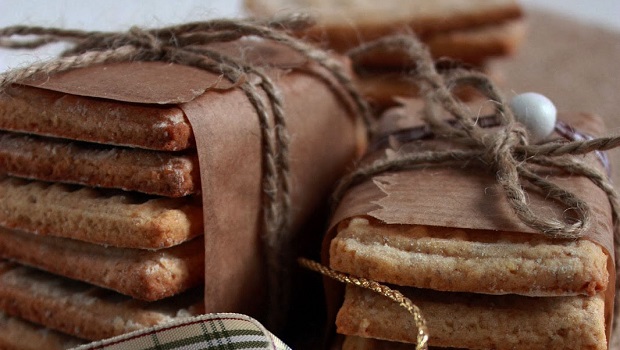
Poppy Seed Roll And Walnut Roll
These are very similar recipes but the filling is different. Both of the rolls are made of homemade dough and they are filled with poppy seeds or walnuts. The fillings beautifully harmonize with the dough while the ecstasy of the combined flavors and aromas is just amazing!
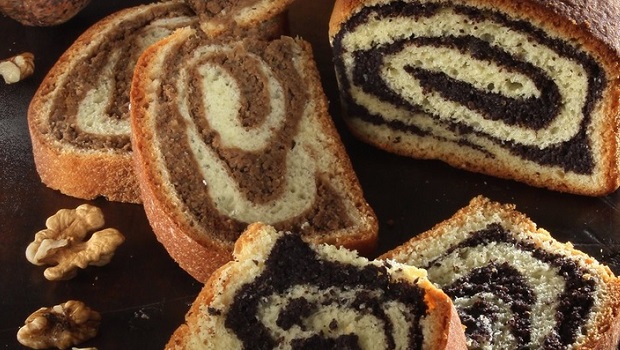
The best way to describe rožata is to say that it is a traditional Dalmatian pudding and that it presents a beautiful heritage of Croatian gastronomy. It dates from 1300 and it perfectly combines liqueur, lemon, and caramel into a seductive symphony of flavors and aromas. This is a perfect dessert for hot summer days and your taste buds will truly enjoy it!
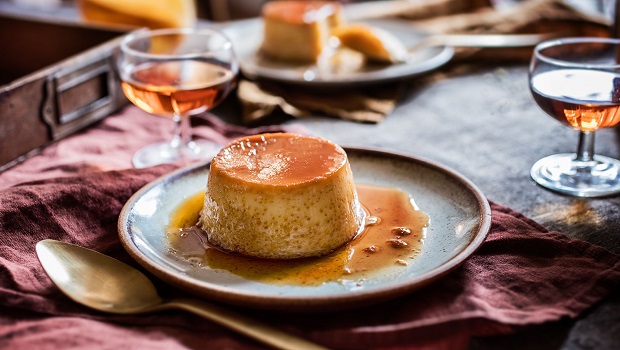
Rudarska Greblica
Called after a small town Rude near Samobor, rudarska greblica is an old dessert with a long tradition of preparation. The dessert is salty and filled with cheese. It can also be filled with walnuts, yellow carrots, young onion leaves, nettle, or spinach. This recipe is actually not only great as a dessert but it can also be a cold appetizer. All the used ingredients create an outstanding mixture of flavors.
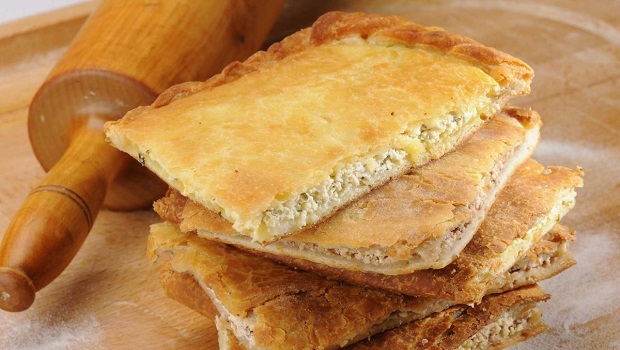
This dessert is often called a Croatian croissant so yes, it is hard to resist it. Salenjaci are made of pork fat and they are filled with jam. This recipe is the most popular one in the region of Slavonija but it is always welcomed in the rest of Croatia too. Salenjaci are sweet and small cookies that will surely win you over.
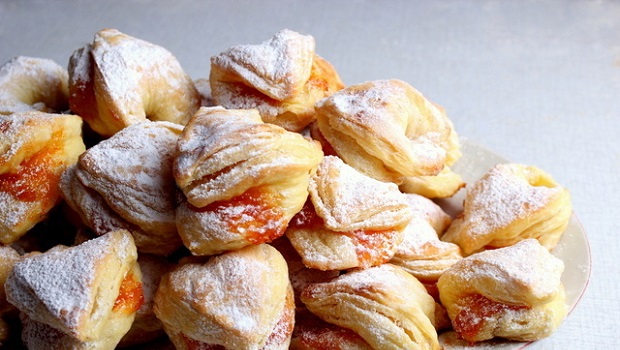
Samobor Cream Puffs
If you ever come to Samobor (and you should), you have to try its cream puffs. This is a delicious dessert that is made of crispy pastry and whipped cream. Unlike most creamy desserts, this one is served warm. The Samobor cream puffs are rich in flavor, sweet, and just perfect! Oh, and we need to mention that they are big – so trust us, one will seduce you and do its job!

Skradin Cake
Every household in Skradin has its own recipe for this cake. The cake presents a Croatian souvenir and it dates from the 14th century. The Skradin cake has an intense and strong flavor and it is made of walnuts, almonds, and eggs. There is also a touch of cinnamon, honey, lemon, orange, rose brandy, prosecco, and rum. Now, imagine all the ingredients mixed up while their flavors and aromas are the key components of that rhapsody. Oh, the cake is also covered in chocolate. We know – we want it now too!

Trogir’s Rafioli
This dessert is, according to the legend, called after miss Rafioli. She was imprisoned in the tower so she baked cookies to fulfill her days. Well, the flavors of this dessert are certainly legendary. Trogirski rafioli are traditional cookies filled with ground almonds. They are rich and juicy, and their flavor is like you’ve never tasted before!
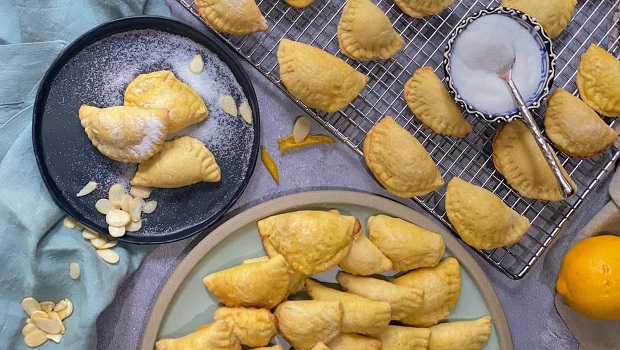
Zlevanka is a traditional recipe of northern Croatia. Zlevanka basically means that you mix all the ingredients and then pour them into a baking bowl. This dessert is a homemade juicy dough that can (but doesn’t need to be) be filled with fruit or cheese. Whichever combination is your choice – you can’t go wrong!
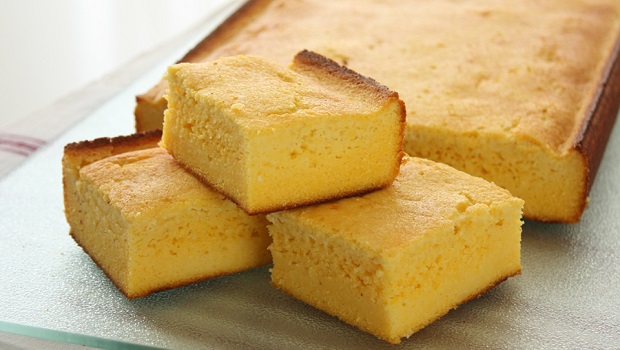
Let’s Wrap It Up!
Each and every one of these 76 recipes come with its own unique flavors and aromatic aromas but they all have something in common – they are the most delicious traditional dishes you can find, try, and taste during your vacation in Croatia! From cold and hot appetizers to pasta, main courses, and desserts – each recipe is respected and nurtured and it is passed down from generation to generation. Oh, and do we need to mention that you’ll have a gastronomic experience of your life? It is a guarantee!
Which recipe is on your must-try list? Let us know in the comments down below!

Combination To-Die-For: Why Is Nutella So Tasty With Butter?
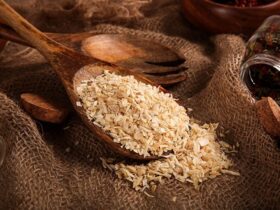
How Much Dried Minced Onion Equals One Onion?
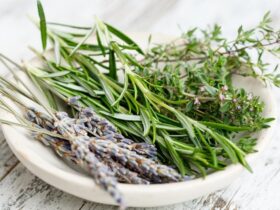
Travel Through The Mediterranean Roads Of Herbs & Spices
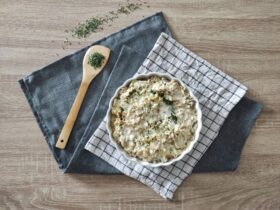
Cooked & Baked: Appetizing Hake With Potatoes Recipe

How Long To Boil Potatoes And Carrots – Can You Boil Them Together?

Cooking Steak On Nonstick Pan – Is It A Good Idea?

Prepare Delicious Summer Desserts With Fresh Mediterranean Fruits
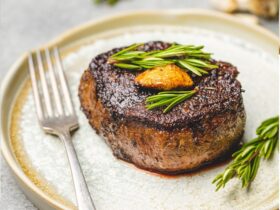
Best Oil For Searing – Make The Most Delicious Steak
Trending Post : 52 Best Things to do in Ireland

16 Fabulous Croatian Food Experiences in Istria
Some of the best Croatian food experiences can be found on the small peninsula in the Istria region, just a few hours from the capital of Zagreb.
The Istria region of Croatia is one of the world’s top foodie vacation destinations. With gourmet restaurants, unique tasting experiences, and some of the best truffles the world has to offer. It is a gastronomic destination well worth a visit.
Ads are how we pay our bills and keep our blog free for you to enjoy. We also use affiliate links; if you make a purchase through them, we may receive a small commission at no cost to you.

Top Croatian Food Experiences: The Istria Foodie Trail
Istria is a peninsula on the western edge of Croatia , across the Adriatic Sea from Italy and south of the Slovenian border. It’s about 3 hours by car from Zagreb , and if you’re a food lover, it’s hard to beat the incredible gastronomy experiences that Istria has to offer and the Croatian food options on hand. Here’s what you need to know about this hot foodie destination and what Croatia is known for .
History of Istrian Gastronomy

Croatian food in the Istrian region is heavily influenced by Italy, as it’s located across the Adriatic sea from Venice and has historically been part of Italy in the past. The Venetians ruled the area from the 13th century until the 19th century, and the area later became part of Italy again during World War II.
During this period, Istrians weren’t allowed to speak Croatian and could only speak Italian. As a result, most residents of the area now speak both Croatian and Italian.
The area is very well known for creating dishes that have hints of Italy along with Croatian traditions. It’s hard to visit any restaurant and not have a great bottle of olive oil on the table and recipes on the menu featuring the sought-after and decadent white truffles. Of course, you’ll also find the wonderful wines of the region to complete a delectable Croatian foodie experience in Istria.
Istria County is the most prominent Italian-speaking part of Croatia, which makes a lot of sense considering its history.
Istria is the land of truffles, olive oil, wine & delicious food

Truffle Hunting in Buzet

The town of Buzet is considered one of the truffle capitals in the world and is located in the center of the Istrian peninsula. Truffles are rare subterranean fungi that are highly sought after in the culinary community and considered a delicacy. Not only can you find truffles on most of the menu at most restaurants in Istria, but you can also book a truffle hunting experience when visiting the area.
The Karlic family is one of many who offer truffle hunting tours from Buzet. Along with the tour is a visit to their kitchen to learn about white and black truffles and the opportunity to sample fresh truffle-based dishes, such as truffle eggs, truffle wine, truffle honey, and even a chocolate truffle dessert.

A tour with the Karlic family begins in their restaurant with an overview of black and white truffles and how they hunt for them. First, a tasting of an assortment of truffled ingredients such as truffle oil, truffle cheese, truffle butter, and many others.
This is followed by a cooking demonstration of truffled eggs. Don’t forget dessert! In Croatian truffle country, everything is better with fresh truffles!

Next, a visit to their shop that sells just about anything you can think of that might contain truffles. This is followed by heading to the forest to observe the dogs and truffle guide in action. Truffle hunting is really the job of the dogs, as they sniff out potential locations of the truffles.
If the truffle guide thinks a dog has found a truffle, he quickly starts to dig to find the truffle. Sometimes it’s a race between the dog and the truffle guide as the dogs like truffles as much as we do and they will gobble them up if given the opportunity.
The Motovun forest is the biggest in Europe for white truffle hunting.
The town of Buzet also hosts the annual Subotina truffle festival in September, where you can sample local truffles and enjoy a number of other local festivities. This is one of the best times of year to try white truffles, which are generally only available in the fall and early winter and are extremely rare.
Fresh Olive Oil

The Istria region is well known for its excellent olive oil. In fact, the region has been recognized to have the best extra virgin olive oil for five years running by Flos Olei, an expert olive oil guide. You’ll find olive oil producers throughout the region, but one of the best places to sample it is at the Days of Young Olive Oil Festival.
This festival is held in the town of Vodnjan in mid-November and brings together over 200 Croatian olive oil producers. Over 20,000 visitors flock to the area during this three-day event.
Istrian Wine & Wine Tasting in Motovan

While visiting Istria, you’ll want to be sure to go wine tasting. The town of Motovan is one of the best places to do so, with six different wineries in the area. Novak Wines and Tomaz Wines are both located in Motovan, while highly-rated Fakin is located a bit on the outskirts. Malvazija is the region’s native white wine, while Teran is the area’s native red.
Motovan is a very old medieval fortification town that was heavily influenced by Venetian rule, but has a very creative, artsy vibe that makes it very fun to explore. You’ll find charming cafes, art galleries, boutiques, and restaurants in the old walled city. In the countryside, there are many wineries open for tastings.
Local Farmers Markets
The farmer’s markets throughout Croatia are a standard way to shop. It’s a daily ritual for most to head to the market to pick up produce, fish, meat, cheese, and other products. As well a the produce market, most towns have a seafood market, meat market and inside market selling everything from pasta to spices. They are well worth a visit!

Food & Drinks You Must Try When in Croatia
The Gastronomy scene of Istria is tied to truffles, olive oil & wine as well as great food. Here are a few dishes you should try during a visit.
Fresh Seafood

The Istria peninsula is on the Adriatic Sea, so it’s no surprise fish is a main dish found throughout the region. They have some of the best prawns in the world as well as great fish dishes. My favorites were the whole grilled fish as well as the fish carpaccio. Another favorite on the coast is fish soup.

If you are a foodie, you need to book a trip to the Istria region of Croatia! Here are a few of the specialties of Istria and throughout Croatia.

Soparnik looks a bit like pizza and is the most famous specialty of the Dalmatian region. Its dough is rolled very think and filled with chard and lots of garlic and baked in an open oven.
Pag cheese is a Croatian variety of hard cheese made from sheep’s milk and originated from the Adriatic island of Pag. It is the most famous cheese made in the country and can be found on most restaurant menus and in most farmer’s markets. Pag cheese pairs exceptionally well with Malvazija white wine.

Prosciutto, which is dry-cured ham, is a favorite Croatian food and used widely in their cuisine. You’ll find homemade prosciutto throughout the country and on most restaurant menus, especially in Istria and Dalmatia.
Croatian fritters (fritule) are a traditional pastry that hails from the Dalmatian coast. Fritule is found everywhere in Croatia. They are light and sweet and a perfect bite of deliciousness!
Local Honey

Croatia has a long-lasting tradition in high-quality honey production. The number of beekeepers in Croatia is constantly growing and is one of the most successful parts of Croatian agriculture. The honey is delicious and is served on many breakfast buffets at many hotels.

Croatian’s love chocolate. The most famous chocolatier in the country is Kraš and their brand Brajadera is one of the best-known chocolate in Croatia. You can find a Kraš chocolate shop in most large cities.
Crni Risotto (Black Risotto)

Crni Risotto, also known as black risotto origins can be traced back to the coastal regions of Croatia, where the Adriatic Sea has played a pivotal role. It is made by blending cuttlefish ink (similar to how squid ink is used in cooking) into short-grained rice. This dish is black in color and has a rich seafood taste.
The most popular beer in Croatia is Ožujsko is also the first Croatian beer made in the country. The second most popular is Karlovačko. Ožujsko, also known and marketed as Žuja, is a lager beer. There is also quite a big craft-beer movement in Croatia and especially in the bars of Zagreb, Split, and Osijek.
Top Restaurants in Istria
As of January 2020, there are five restaurants with a Michelin star in Croatia. Noel in Zagreb, Draga di Lovrana in Lovran, Pelegrini in Šibenik, 360 in Dubrovnik and Monte in Rovinj. Of course, it’s not all about a Michelin star! There are an amazing amount of delicious traditional restaurants throughout Istria as well as ones creating culinary history.

There are many great places to dine in Istria including Croatia’s first Michelin star restaurant, Monte. In fact, it would be difficult to enjoy all of them in one trip. Here are some of the must-visit restaurants in the area.
This restaurant is located in the small coastal town of Rovinj, which is often compared to Venice in terms of architecture, food, and the general feel of the town. Monte became the first restaurant in Croatia to receive a Michelin star in 2016. They provide an incredibly luxurious experience, with creative dishes and modern cooking techniques. The restaurant is located on the top of a hill in Rovinj’s old town within the chef’s family house.
Cap Aureo at Grand Hotel Park

Cap Aureo is located on the 5th floor of the Grand Hotel Park in Rovinj. The view of the old town of Rovinj is absolutely stunning and the restaurant is positioned perfectly to catch the spectacular sunset. The food is creative, delicate and delicious. It’s small bites that are created with precision and meant to be enjoyed over a long leisurely gastronomic experience.
Beyond the views and food, Cap Auero also has some of the best gender signs for bathrooms. Can you guess which sign is for those who identify as women and men?

Konoba Rino

This traditional tavern in Momjan is one of the best restaurants to experience true Croatian food experience. The restaurant draws a crowd of hundreds every weekend, and many people even come from Slovenia to enjoy the satisfying dishes. Konoba Rino are also known for their incredible beef. The menu is very traditional to the area and includes wonderful local cheese, prosciutto, and truffle dishes.

Restaurant Marina
This small but elegant restaurant in Novigrad is an excellent place to enjoy some local seafood. There is no set menu – instead, the head chef uses fresh local ingredients and the best catches of the day to prepare innovative yet satisfying dishes.
Another excellent restaurant in the northern part of Istria, this tavern is known for its authentic meat and fish plates in a warm, cozy setting. Of course, everything is paired with delicious Istrian olive oil.
Where to Stay in Istria
With its elegant restaurants, charming architecture, and seaside views, it’s hard to beat staying in the town of Rovinj. There are many cozy Airbnb rentals in town, as well as small boutique hotels and B&Bs. The Maistra group owns many of the top hotels in the Rovinj area, including the luxurious Grand Park Hotel . This amazing hotel is set on the water and provides a truly impeccable resort experience. Other reliable options include Hotel Lone , which has a very modern design, and the Villa Tuttorotto , which offers a more traditional experience.
Recommended Travel Resources
- How to Pack for 2 Weeks in Europe (in one suitcase)
- Cheap Flights to Europe with Condor Airlines
Read More About Croatia
- 11 Fantastic Things to Do in Dubrovnik (Plus best restaurants and hotels)
- 50+ Fantastic Things to do in Croatia : Insider Information & Tips
- Jaw-Dropping Christmas Markets in Zagreb (Advent in Croatia)
- What is Croatia Known For?
Read More About Europe
- How to Choose the Best European River Cruise
- Best Barcelona Food Tour: A Sampling of the Gracia Neighborhood
- The 52 Best Things to do in Ireland
- Viking Danube River Cruise – Passau to Budapest
Pin for Later!

Follow 52 Perfect Days on Facebook | Twitter | Pinterest | Instagram
————————————————————————————————————————————-
If you liked it, please share it. Thank you!
- Facebook 718
- Pinterest 159
Alexa Meisler is the editorial director of 52 Perfect Days. Born in Paris, France she has since lived in Chicago, San Francisco, Los Angeles and Portland, Oregon. She currently resides in San Diego with her husband and son where they enjoy exploring California and Mexico.
Travel has always been a part of her life; traveling to such places as Morocco, Tangiers and Spain as a young child as well as taking many road trips to Mexico with her grandparents as a young girl. Since then, she has traveled abroad to locations such as Russia, Taiwan and throughout Europe.
Prior to working at 52 Perfect Days she was a freelance travel writer; focusing on family and women’s adventure experiences.
Leave a Reply Cancel reply
Your email address will not be published. Required fields are marked *
Food Safari Water | Episode guide
Dive into food safari water - the next delicious helping of food safari elements, exploring the bounty of the water..

Source: Food Safari Water
Episode 1 – From The Water

This is what you need to know when you buy seafood

Episode 2 – Sea Treasures

Episode 3 – Whole Fish
Episode 4 – raw.

Episode 5 – Fish Bites

Episode 6 – Fish On Fire

Episode 7 – Shellfish

Episode 8 – One Pot
Episode 9 – preserved.

Episode 10 – Surf & Turf

Episode 11 – Freshwater

Episode 12 – Feel Good Fish
Episode 13 – festive fish.

Have a story or comment? Contact Us
Share this with family and friends
Articles from The Cook Up with Adam Liaw

A case for more tahini in your kitchen

Just add paprika
Food and drink

The essence of my Turkish family, in a bowl of soup
Turkish Food

For the love of lamb

Chocolate or caramel? Or both?

Win a $500 IGA Gift Voucher
Competitions

The one dish chef Claire Van Vuuren could eat over and over
Cooking shows

Jamie Durie helps to make your herb garden grow
The Cook Up
SBS Food Newsletter
Get your weekly serving. what to cook, the latest food news, exclusive giveaways - straight to your inbox..
By subscribing, you agree to SBS’s terms of service and privacy policy including receiving email updates from SBS.
Bring the world to your kitchen

IMAGES
VIDEO
COMMENTS
Author Dennis Valcich runs through the key ingredients used in Croatian cooking and demonstrates a recipe from the Dalmatian coast - artichoke with potatoes ...
Paprenjaci (Pepper Biscuits) 38. Zagrebački Odrezak - Zagreb Schnitzel. This is a tasty dish you'll find everywhere in Croatia, but mainly in the Zagreb region, hence the name! A meaty dish that is very filling and great for the winter months is a veal schnitzel, rolled and filled with melted cheese and ham.
In each episode of Food Safari, Maeve O'Meara visits a different cuisine, taking you into kitchens and restaurants across the nation to learn new recipes.
Ražnjići. Ražnjići is a popular Balkan dish made from pork that is grilled on a barbecue. It is similar to Greek souvlaki and Turkish şaşlık. 5. Restani Krumpir. Restani krumpir is a traditional Croatian breakfast or dish made from sautéed potatoes that are served with sausages. Check out this recipe. 6. Sarma.
Think garlic, onion, bay leaves, and paprika combined with the juiciness of red peppers for an unbeatable combination. Brudet is best served with creamy polenta or mashed potatoes to bring out its flavors even further. 7. Fuži. Fuži is a delicious traditional Croatian dish made of thick, hand-rolled noodles.
It can be eaten plain or with cream cheese frosting or whipped cream topping. 3. Pečene Punjene Paprike. One of the most traditional Croatian recipes is Pečene Punjene Paprike which means roasted peppers stuffed inside a cabbage leaf and then wrapped in bacon and served with cabbage salad and sour cream dressing.
7. Bučnica. Bučnica refers to a type of Croatian savory strudel made with pumpkin, cottage cheese, sour cream, butter, and eggs wrapped in thin phyllo dough. It can be served warm or cold and is especially popular in and around the Croatian capital of Zagreb.
Add vanilla and regular sugar to milk and bring everything to a boil for the sugar to dissolve. Then pour the milk over the ground walnuts. Melt the butter in a smaller pan and add it to the walnut mixture while still hot. Mix the walnut concoction well and allow it to cool before adding lemon zest and rum to it.
Combine the garlic with 150 ml (5 fl oz) of the oil and set aside. Line the bottom of the peka pan with the potatoes and drizzle with the remaining oil. Add the French shallots, carrots and ...
Here are our favorite recipes in English. Ispod Čripnje Or Ispod Peke Recipe - Croatian Cooking. Croatian Vanilla Crescent Cookies Recipe (Vanilin Kiflice) How To Make Croatian Šnenokle (Also Known As Paradižot) Croatian Cooking: Zagorski Štrukli (Zagorje Cheese Strukli) Čupavci Recept - Kind Of Like Australian Lamingtons.
First add the fish, white wine, vinegar, bay leaves and garlic. Cover and cook for 15 minutes over low to medium heat, shaking the pan often. Add the shellfish mixture, cover and simmer over low heat for 15 minutes. Throughout the cooking, it is recommended to shake the pot, but never stir the brudet with a spoon.
Take the other piece of dough and roll it out. Place the rolled-out dough over the chard. Press the edges of the dough and join the upper dough to the bottom. Press the edges well so the filling doesn't leak out. Bake the soparnik for 35 to 40 minutes. During the baking time, chop the garlic and add to the olive oil.
3. Enjoy a Medley of Seafood and Spices with Brudet. A simple, typical Croatian food you'll find along the coast is named brudet, and it's a delicious medley of seafood and vegetables stewed in wine and spices. Brudet is a one-pot meal, and like buzara, you'll find variations of this dish all across the Adriatic Sea.
Jela ispod peke consists of various types of meat such as lamb, beef, and veal, seafood like monkfish and octopus, and vegetables, while it is common to season dishes with herbs like thyme, rosemary, garlic, and onions. Moreover, it's also common to find traditional Dalmatian bread prepared under the bell.
Croatian: With Maeve O'Meara, Dennis Valcich, Mira Valcich, John Bacic. Dennis Valcich runs through the key ingredients used in Croatian cooking and demonstrates a recipe from the Dalmatian coast - artichoke with potatoes and broad beans.
Sold over 10,000 copies already, Croatian Desserts features 50 authentic, easy-to-follow dessert recipes. The glossy cookbook boasts more than 500 color images with step-by-step baking method. With 100 savory recipes and 700 images, Croatian Classics is the only cookbook you'll ever need to master the delights of Croatian cuisine.
Add 600 grams Potatoes (1.3lb) and all the vegetables 1 Courgette, 1 Carrot, 1 Pepper, 1 small Aubergine, 1 large Onion into a large lidded casserole dish. Place diced lamb on top of the vegetables, pour the marinade and 250 ml White wine (1 cup) over the top.
In restaurants, Zagreb steak is served with a slice of lemon because of the acidity, which goes well with breaded meat, and the most common accompaniments are fries or rizi-bizi, boiled rice with added peas. 2. Čobanac (Shepherd's or Slavonian Meat Stew) Credits: @pink_pig_oo.
The ombolo or žlomprt, is a part of a pork chop. The meat is chopped and rubbed with salt, paper, and bay leaf, then it is dried for about 3 weeks. The dish is really simple but oh, so tasty! The ombolo is served with a few drops of olive oil, eggs, and bread. White wine such as Malvasia adds a bit of spice too.
SBS Food is a 24/7 foodie channel for all Australians, with a focus on simple, authentic and everyday food inspiration from cultures everywhere. NSW stream only. Read more about SBS Food. Food ...
Ćevapčići. Ćevapčići are about 5-10 cm long rolls formed from minced meat and then grilled. In the past, they were most often made from lamb throughout Southeastern Europe. However these days people mainly use beef. Before shaping, the meat is seasoned with salt, pepper, paprika powder and cut garlic.
Beer. The most popular beer in Croatia is Ožujsko is also the first Croatian beer made in the country. The second most popular is Karlovačko. Ožujsko, also known and marketed as Žuja, is a lager beer. There is also quite a big craft-beer movement in Croatia and especially in the bars of Zagreb, Split, and Osijek.
Episode 3 - Whole Fish. Food Safari Water joins the pumping kitchen at the popular Golden Century which specialises in live fish and seafood and Eric Wong explains the cultural significance and ...